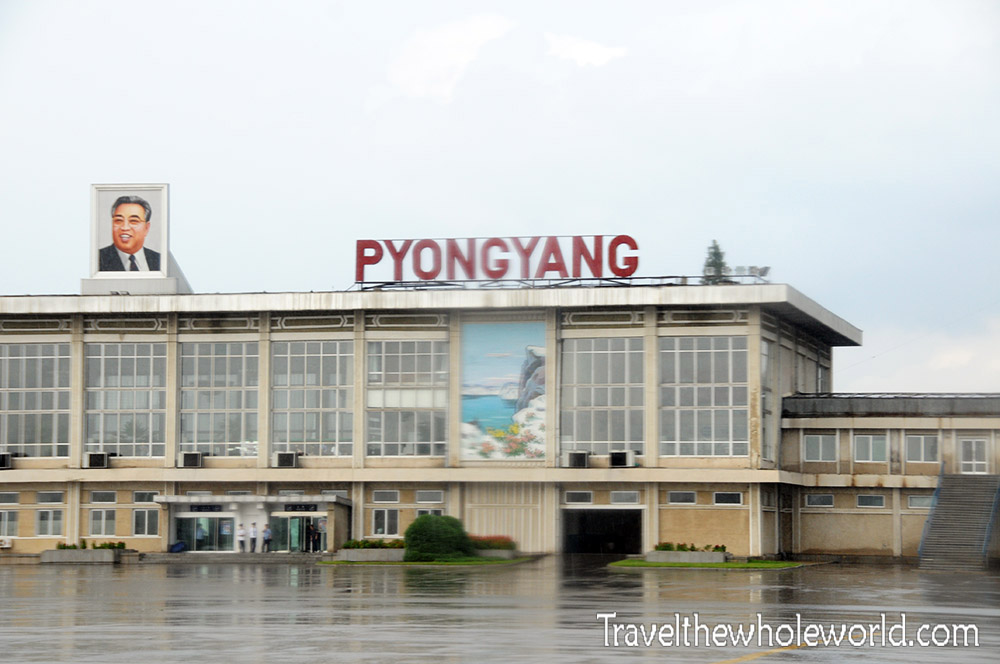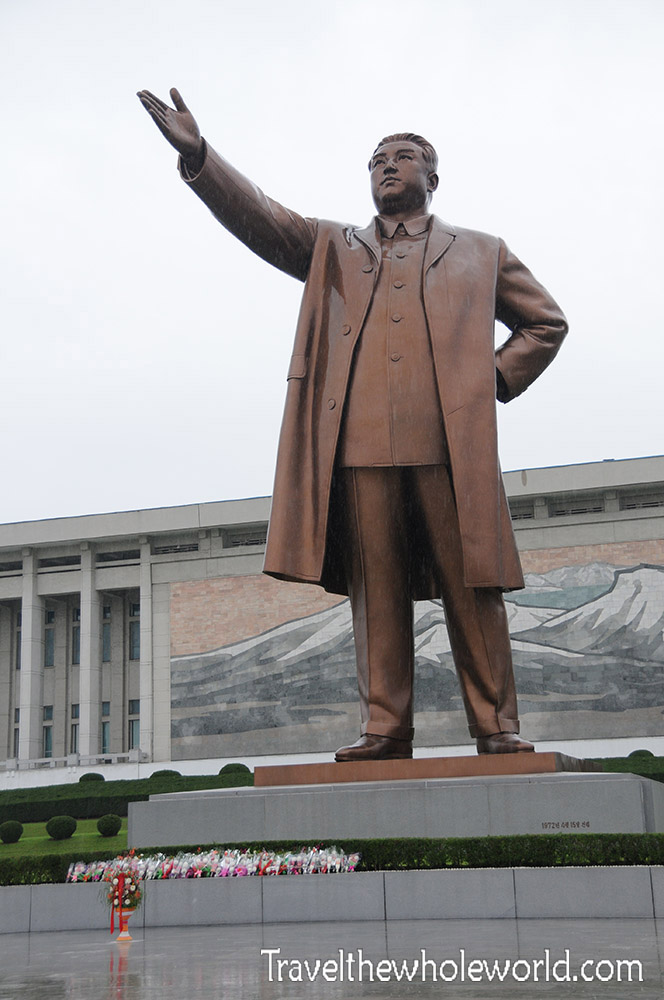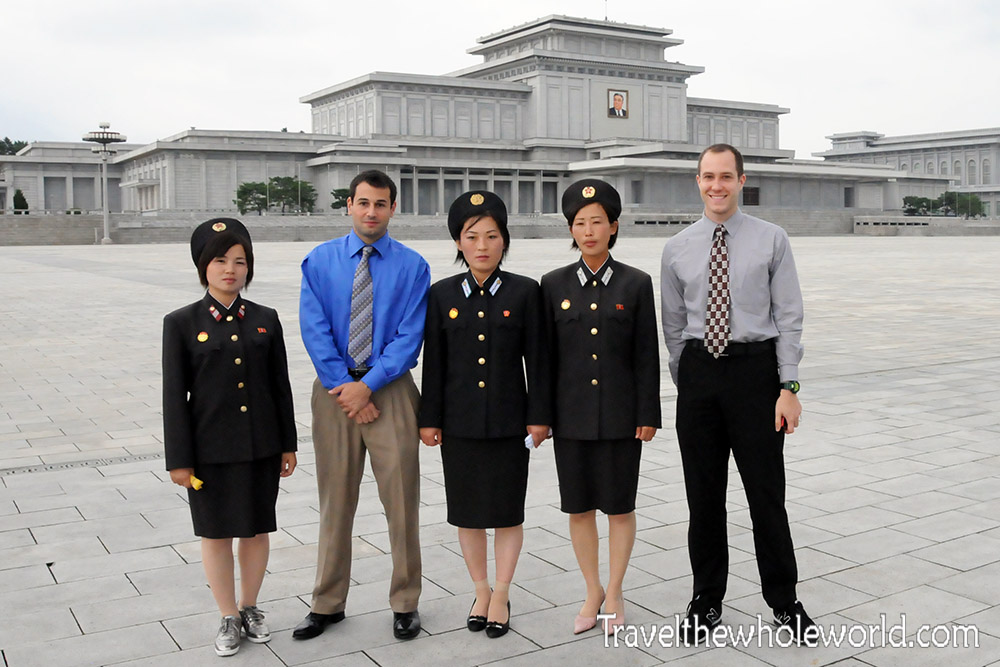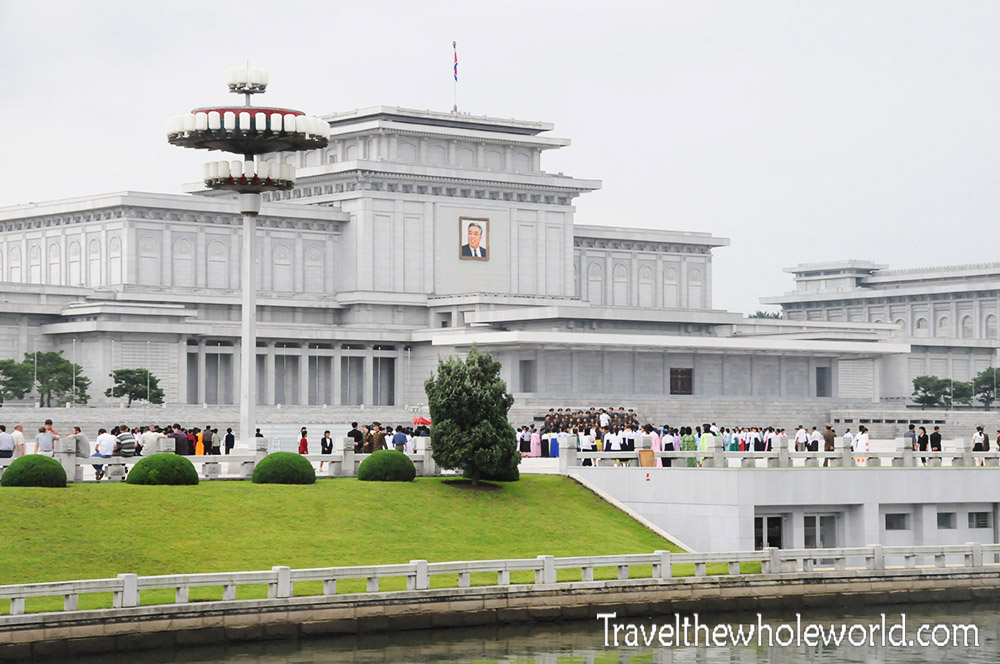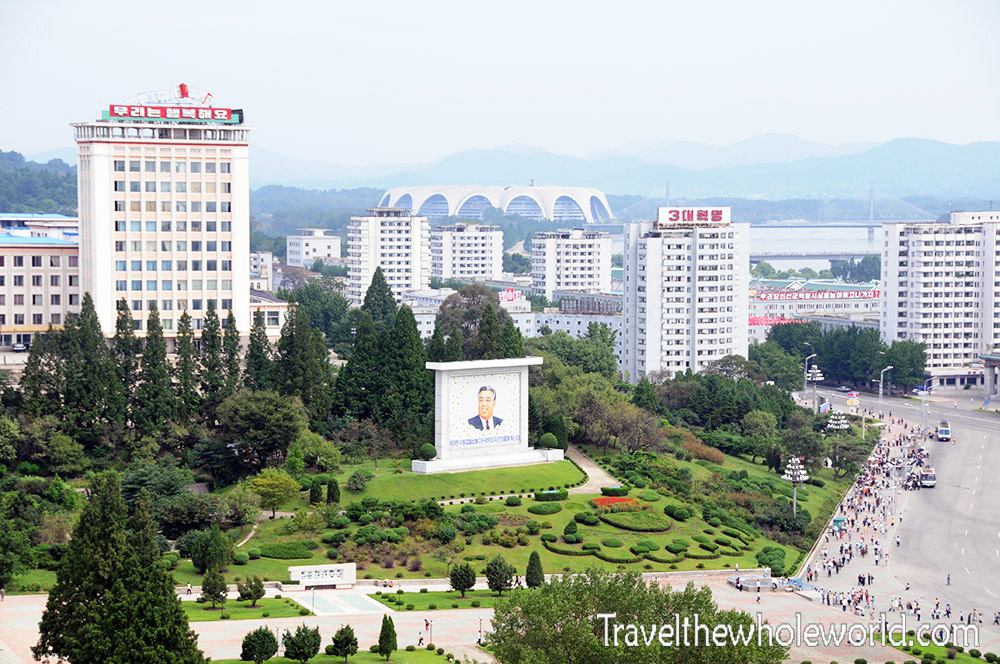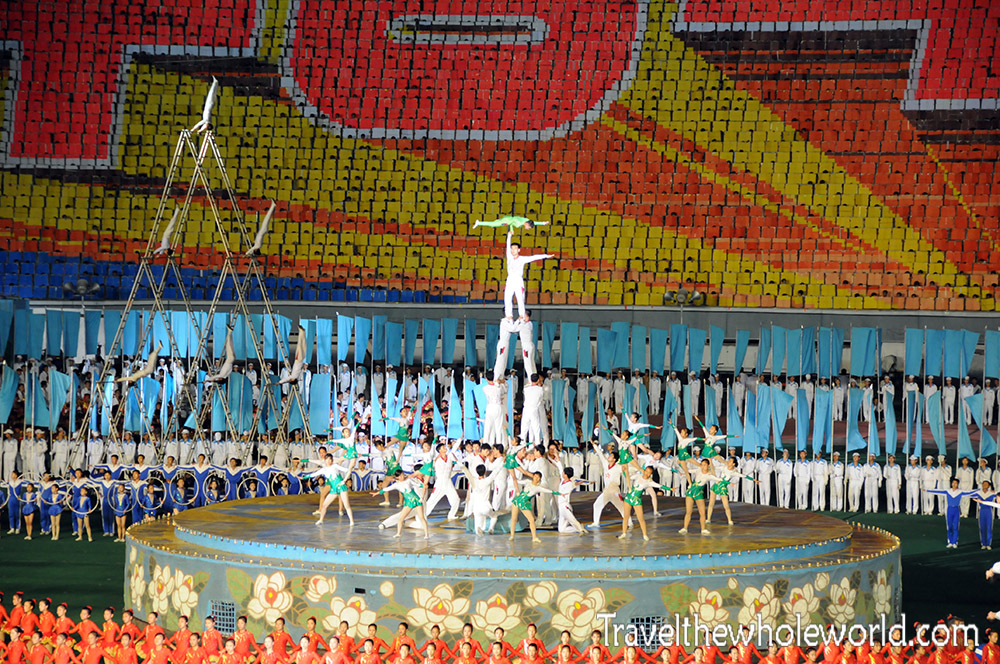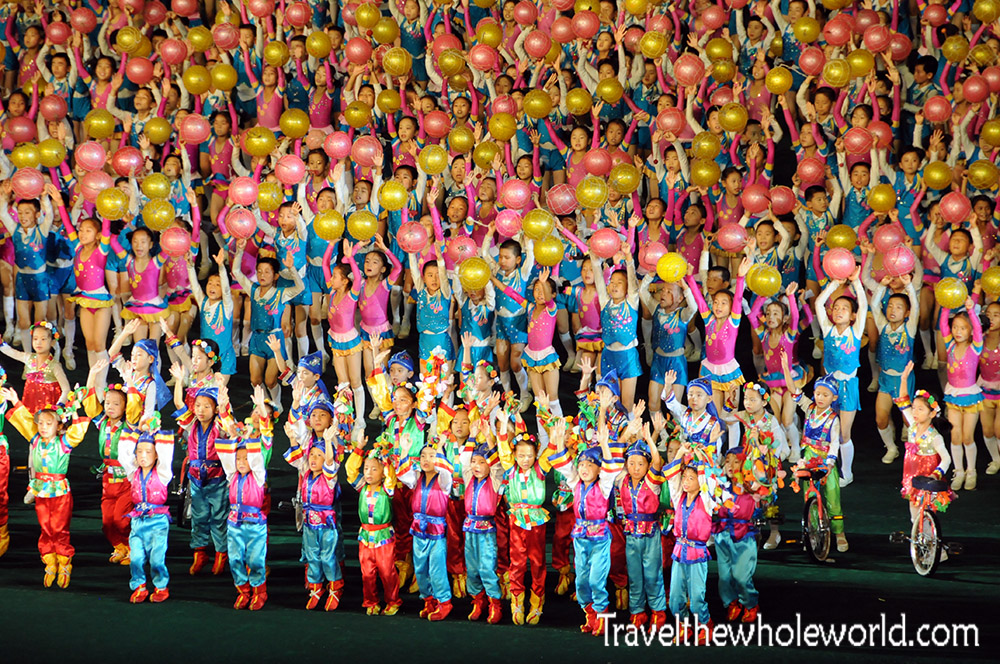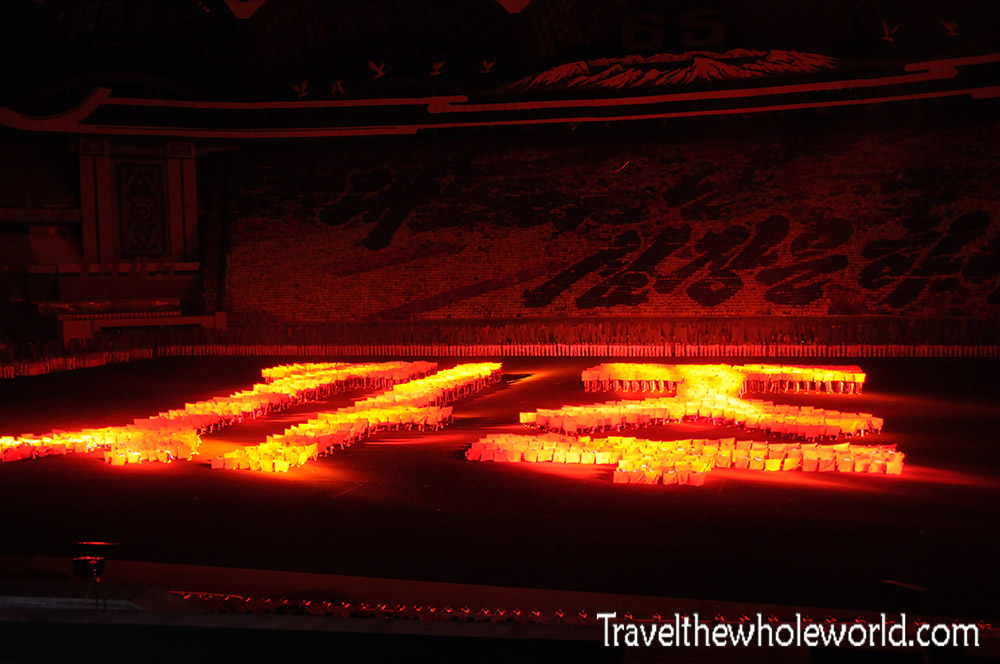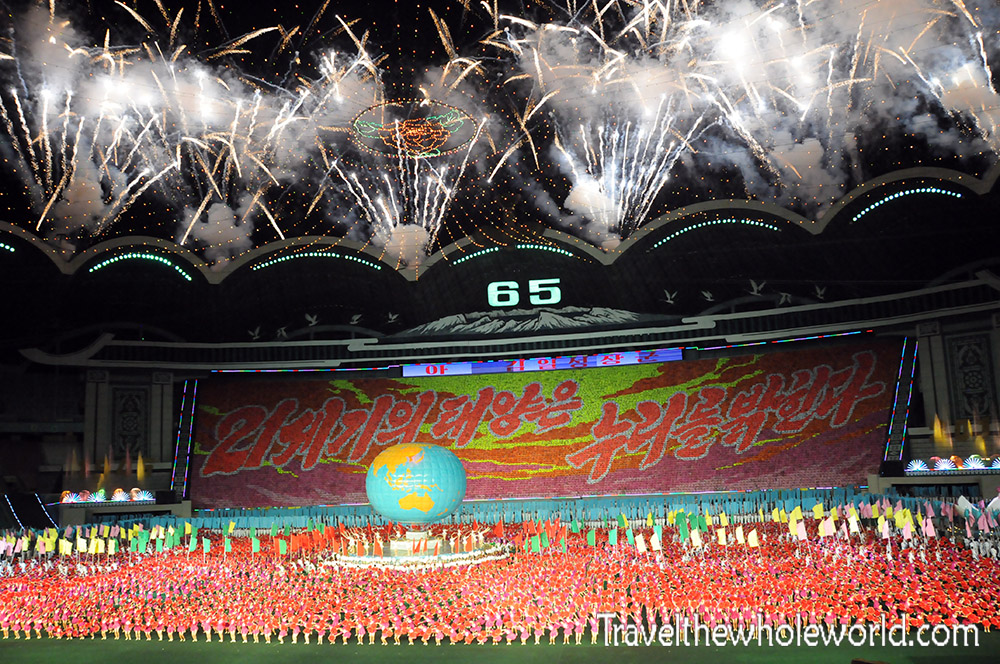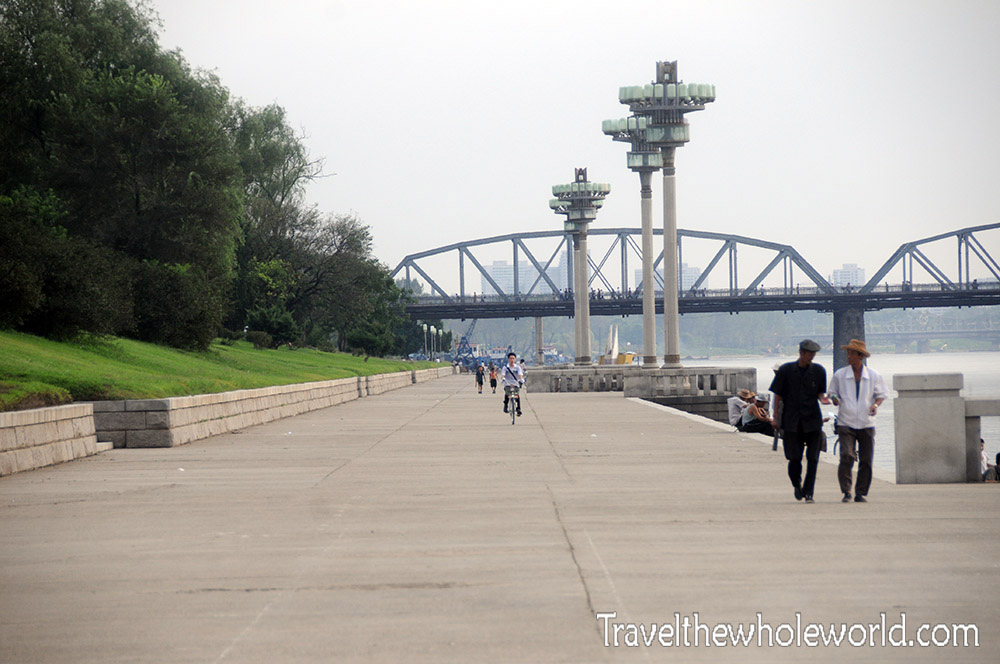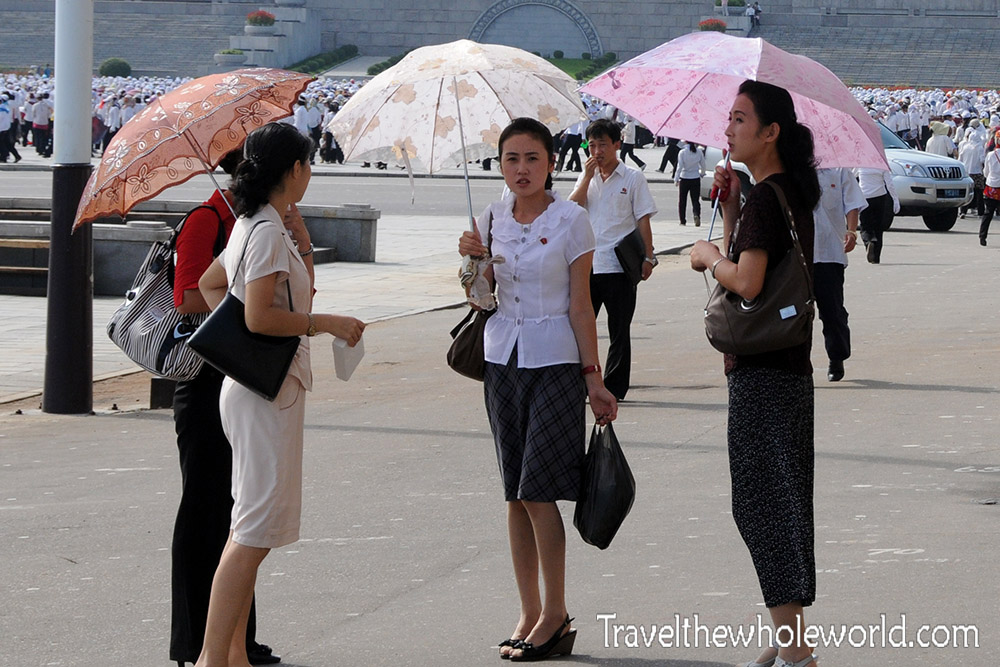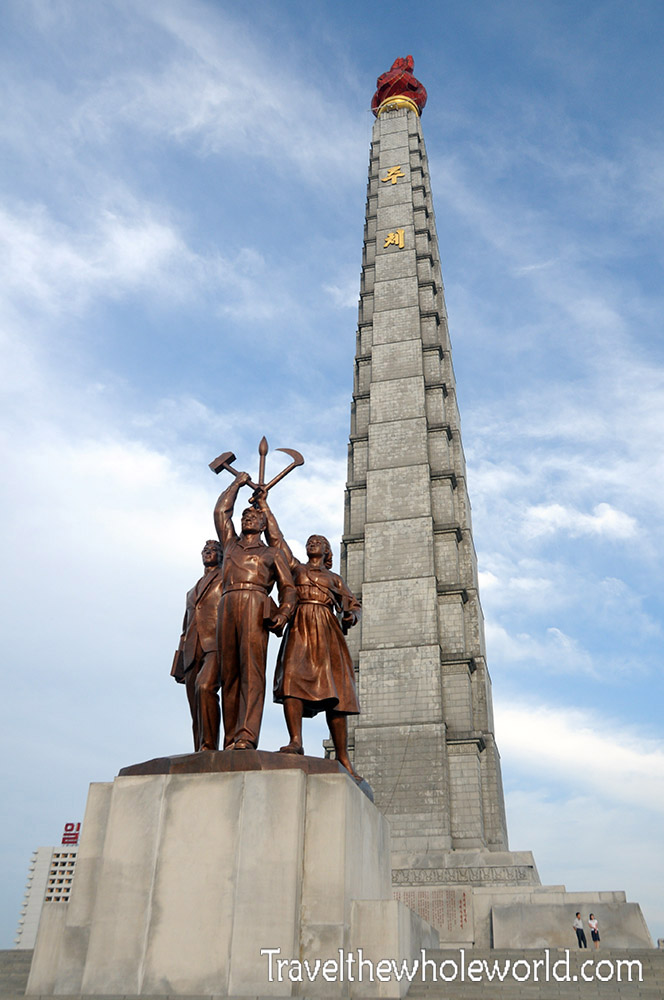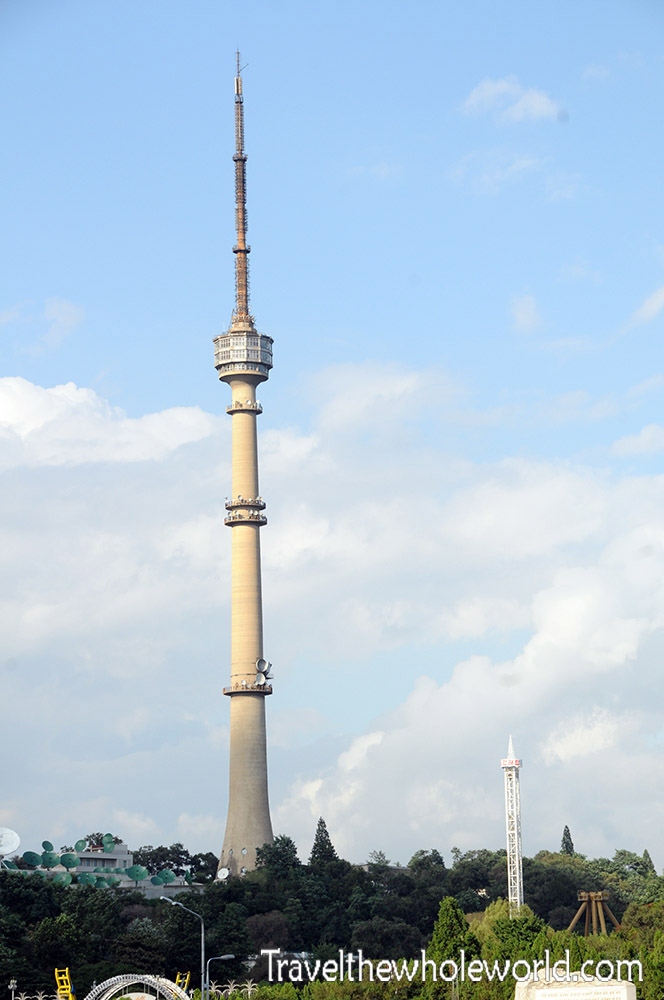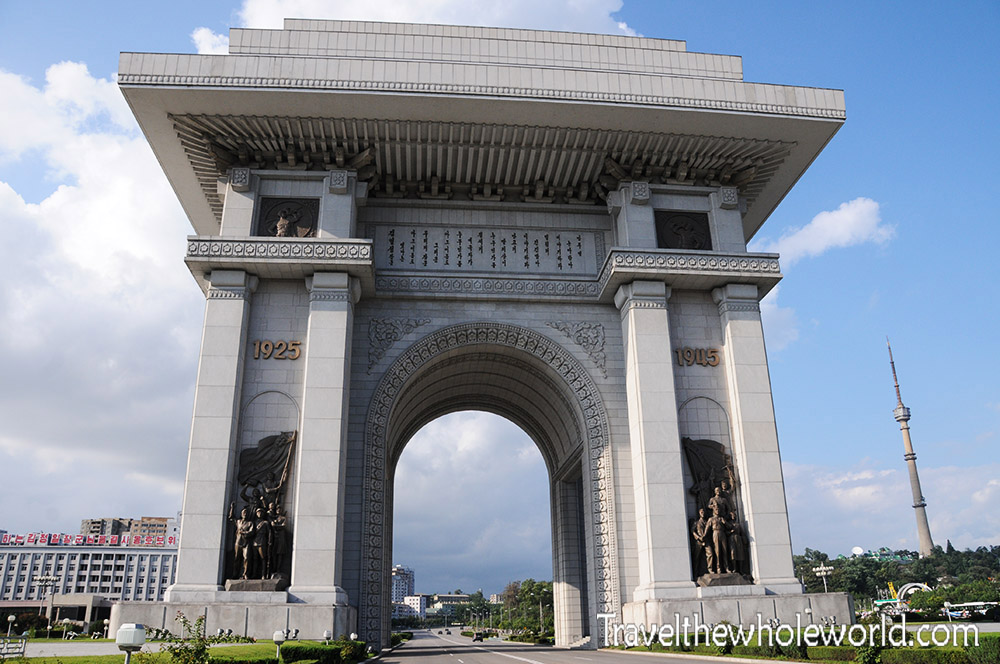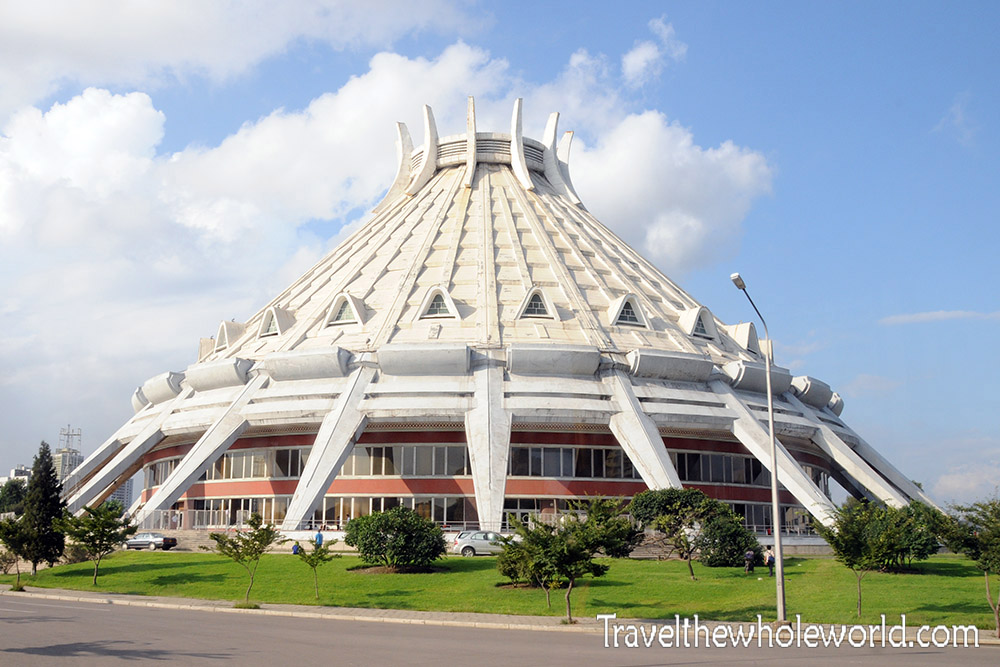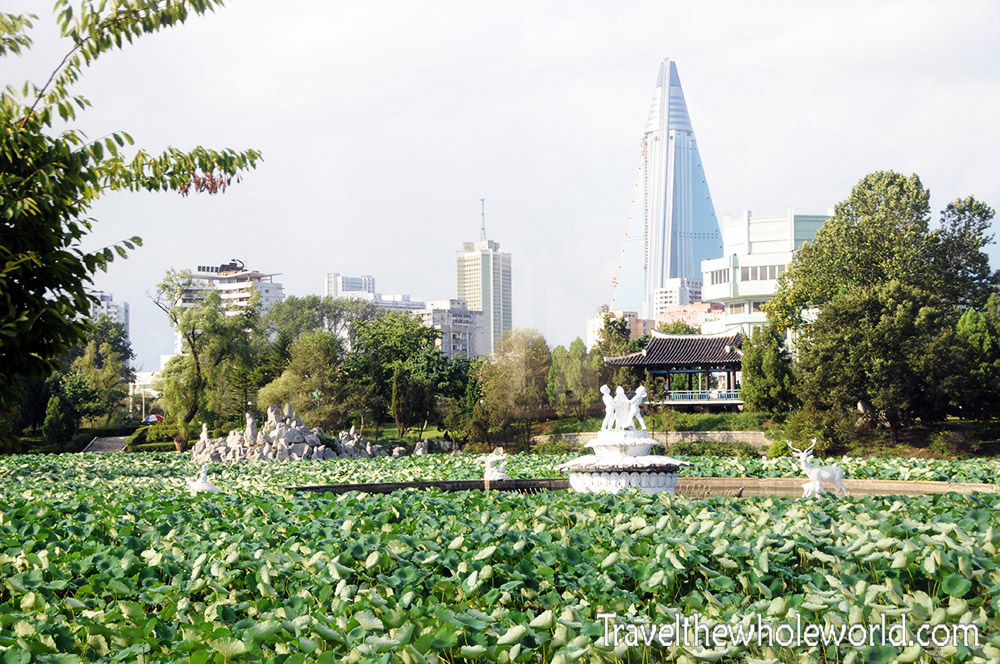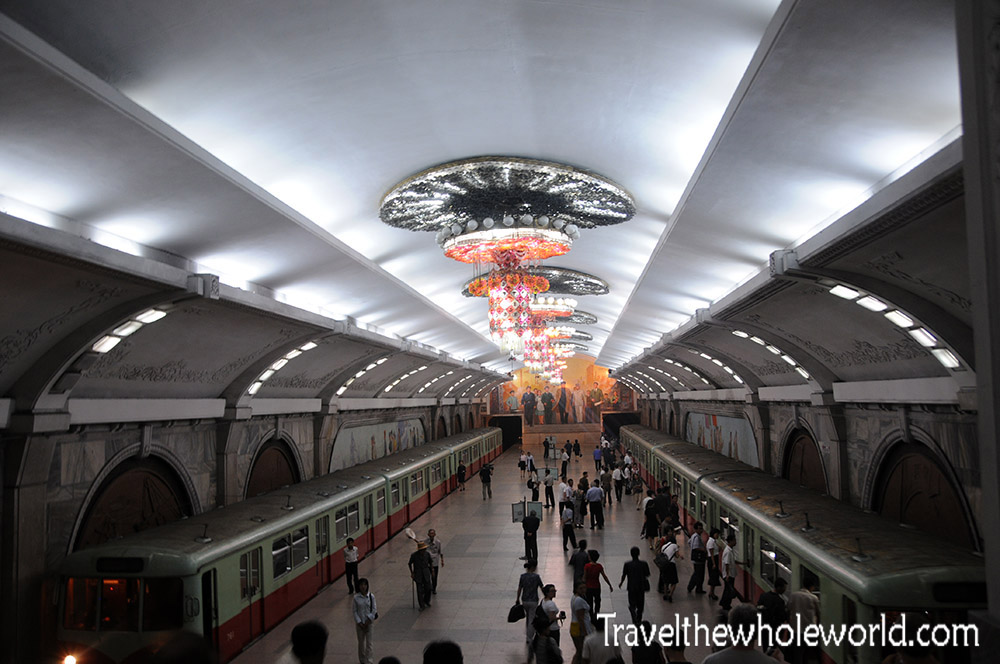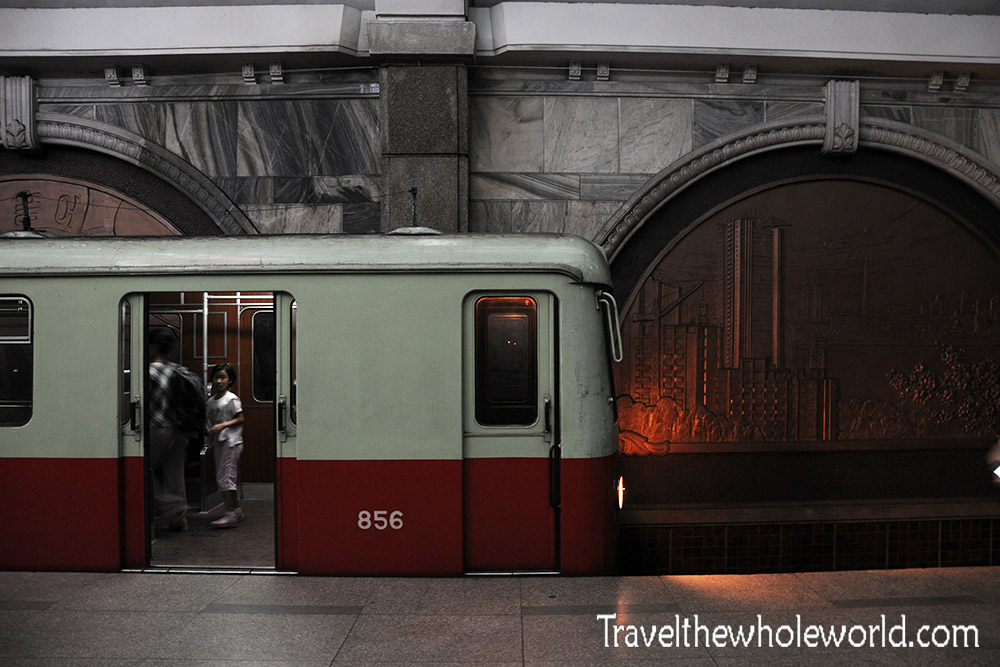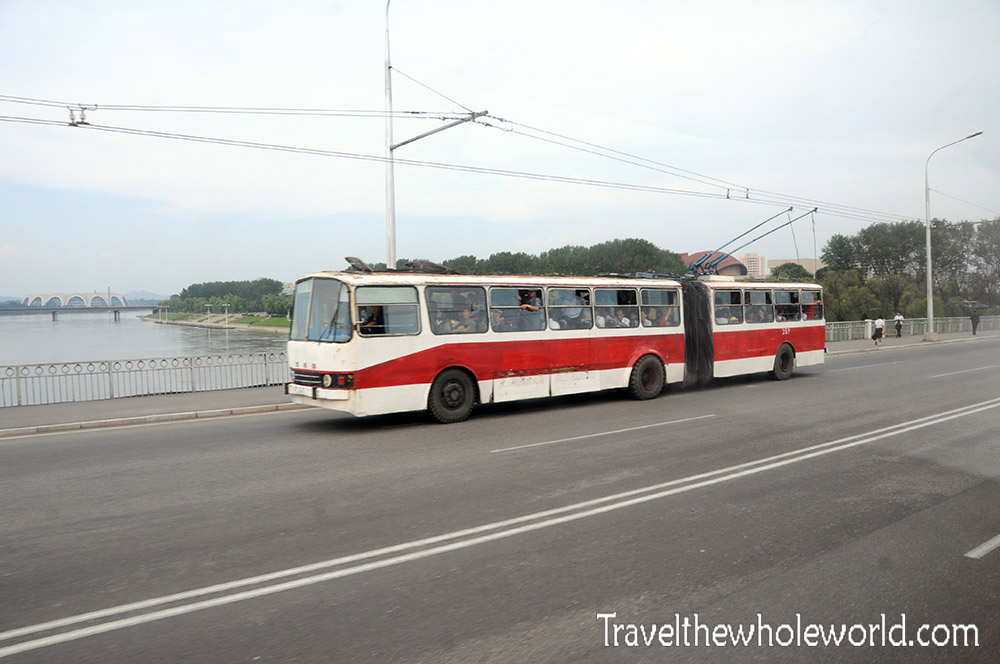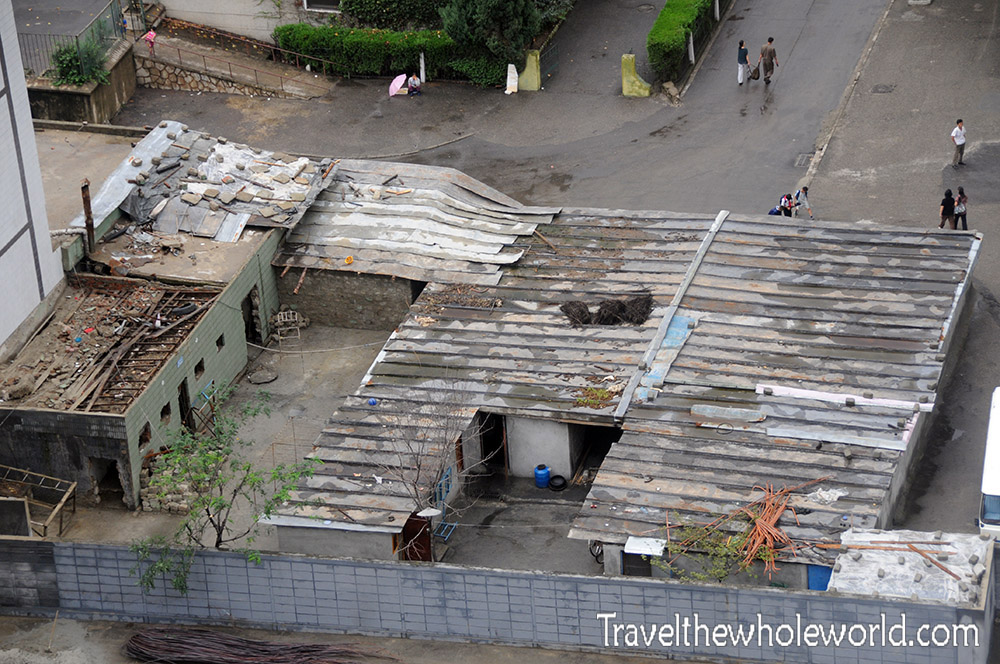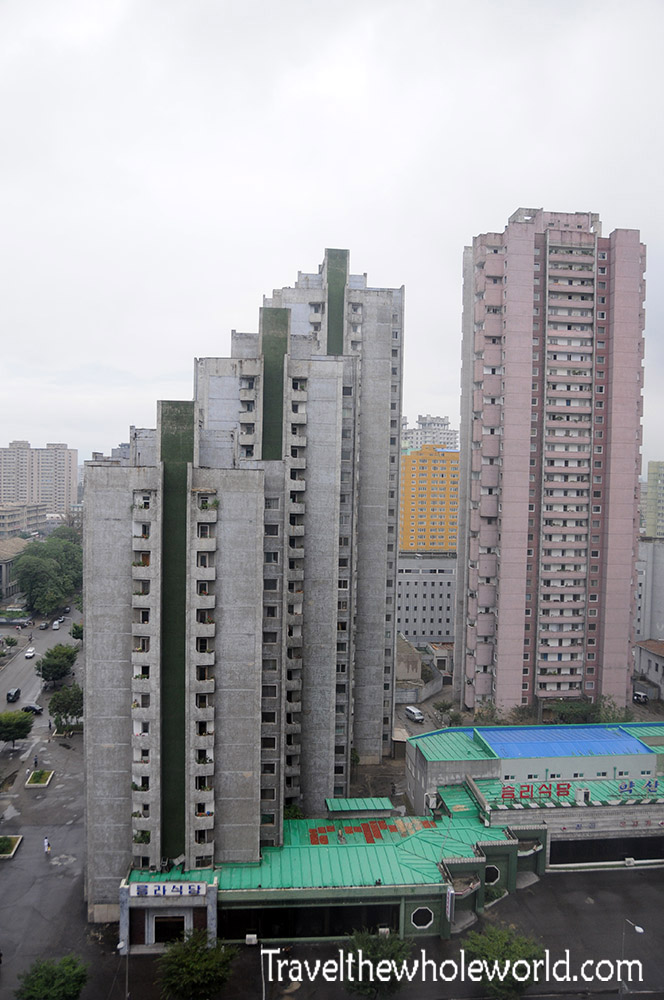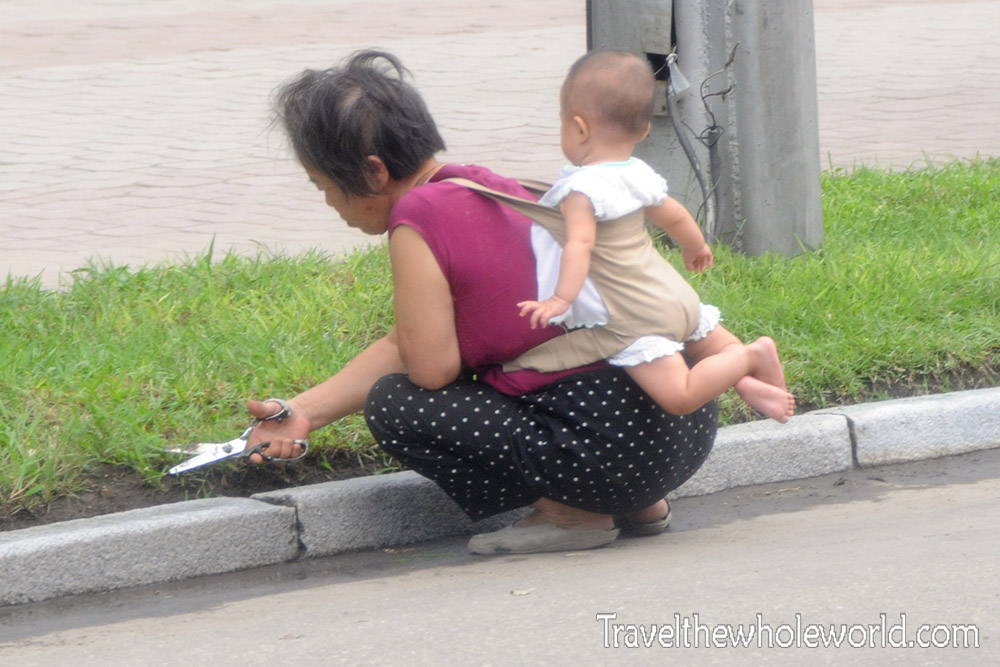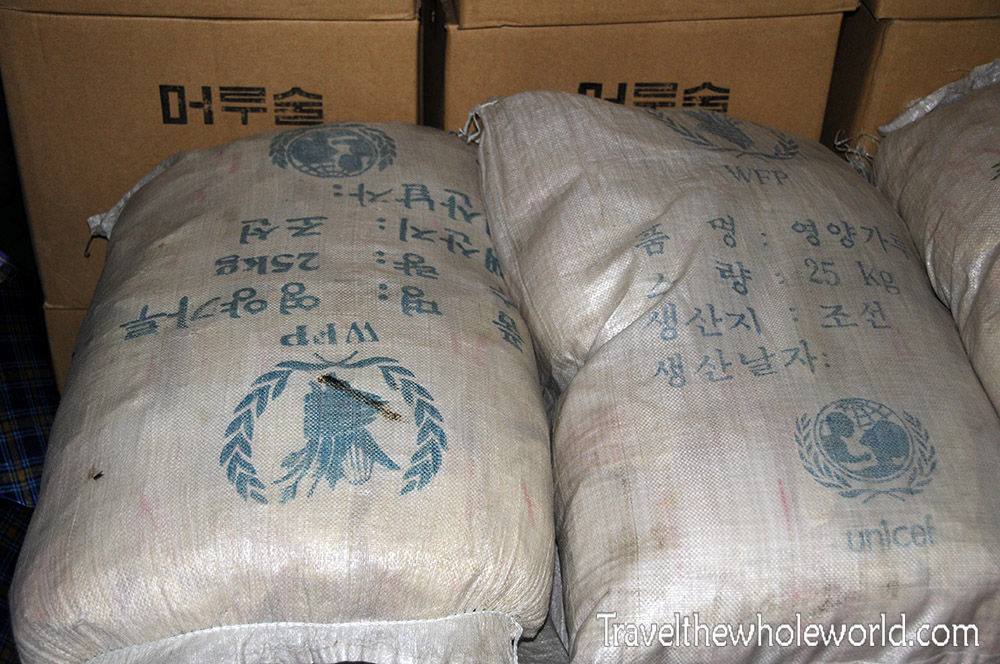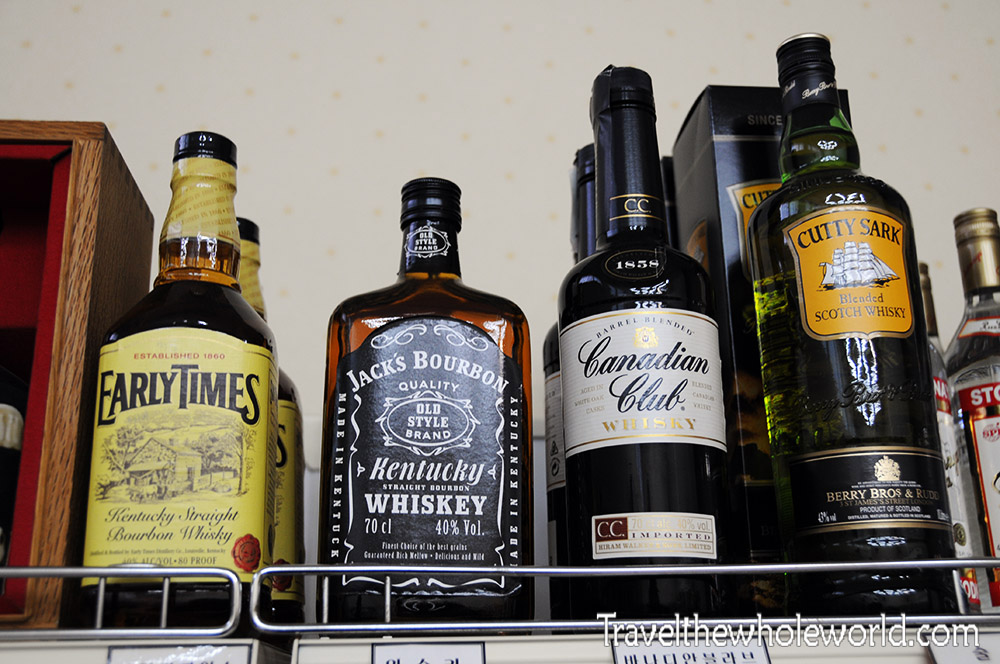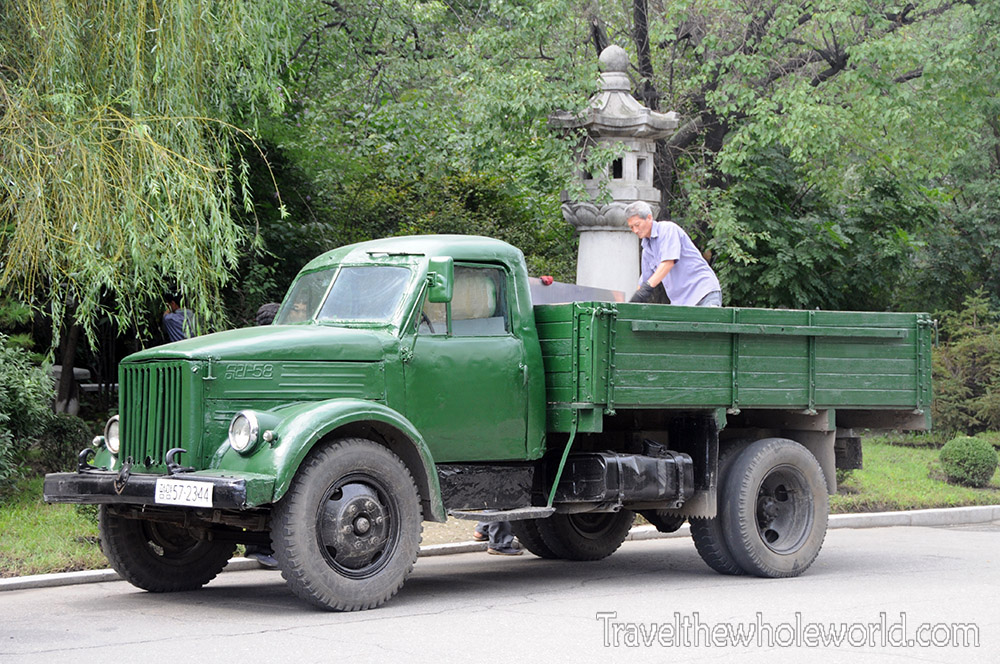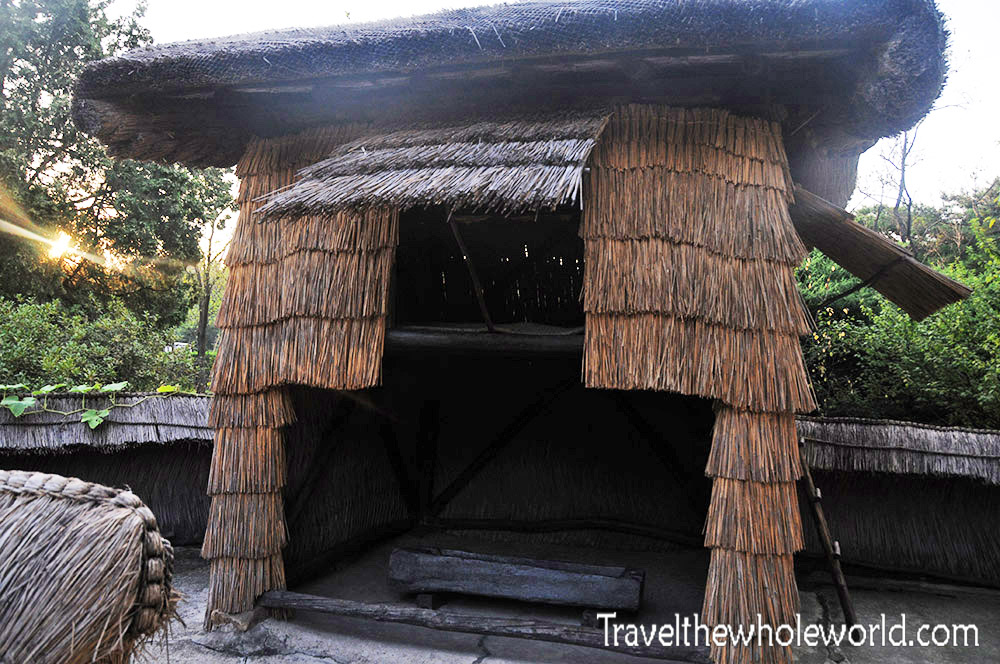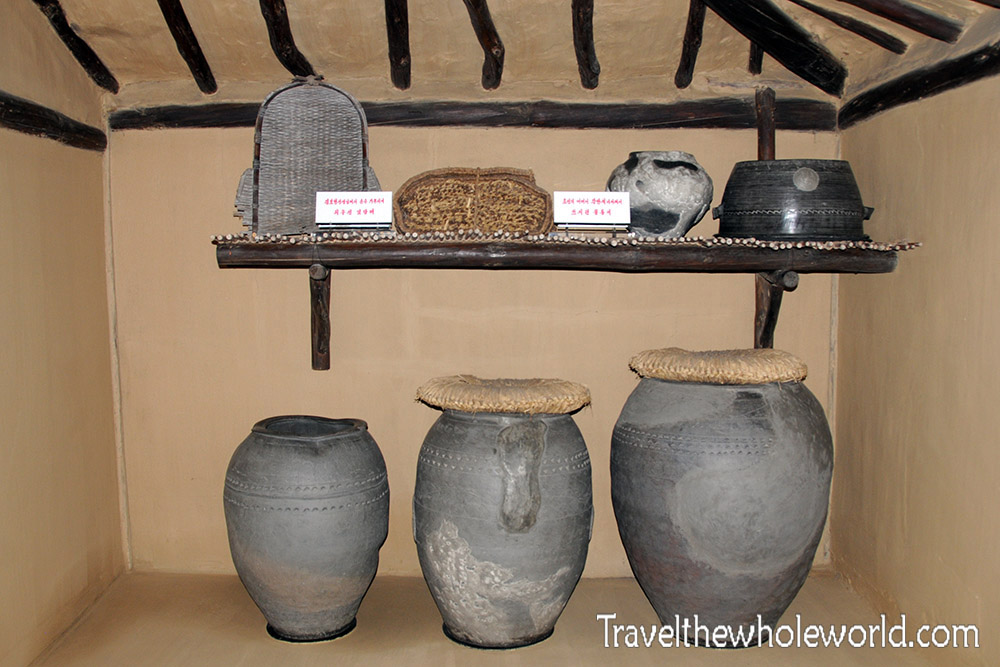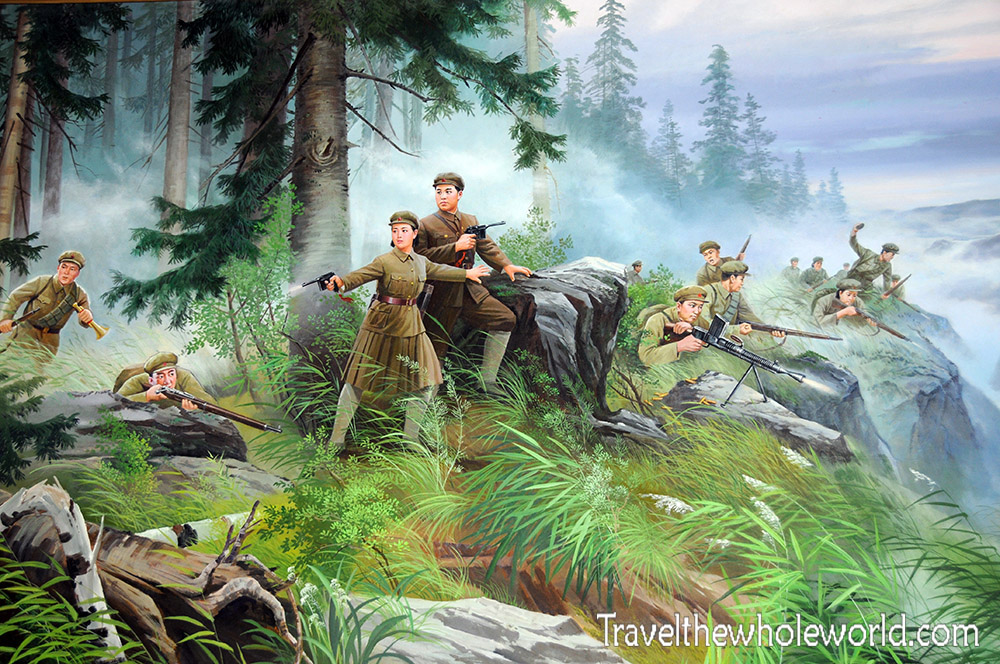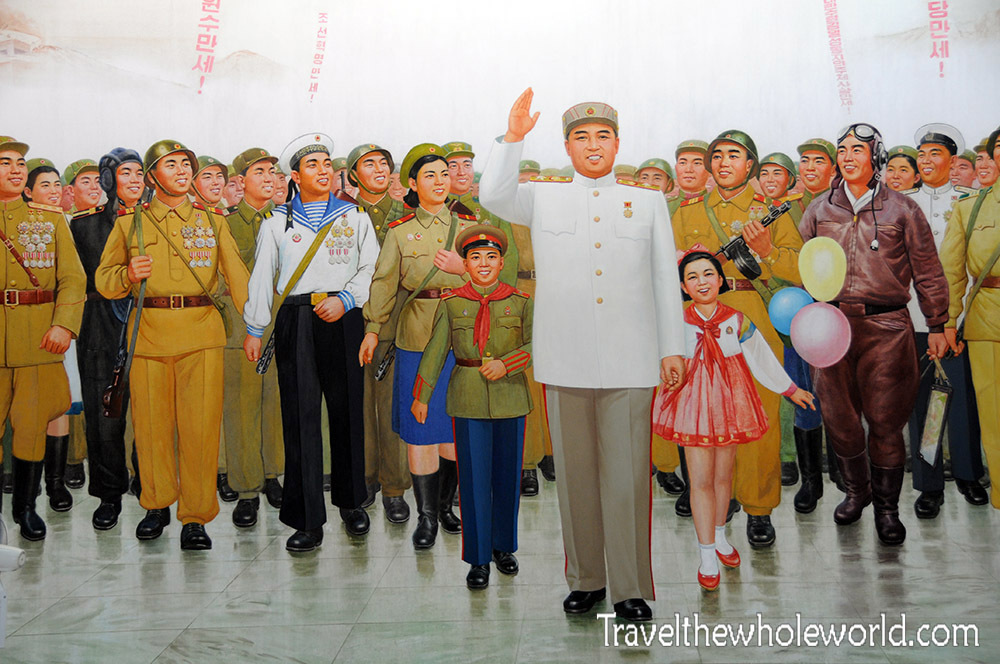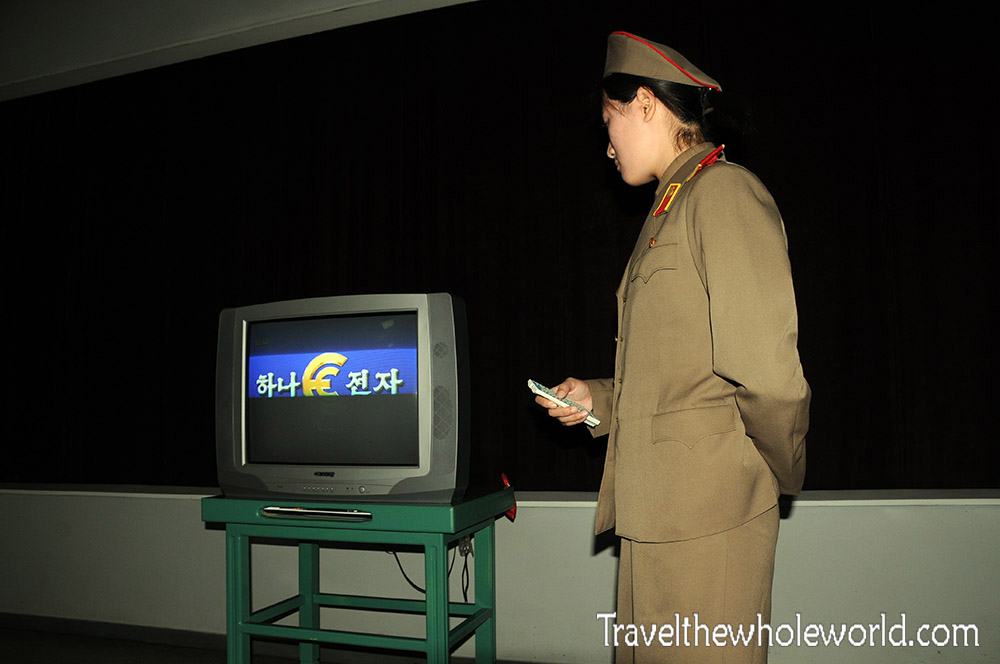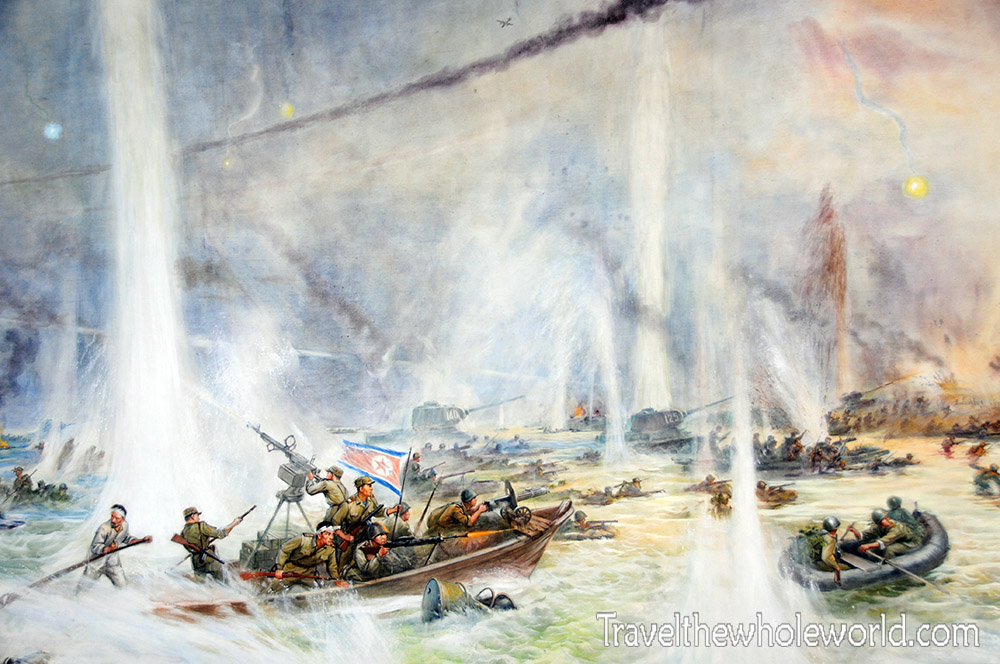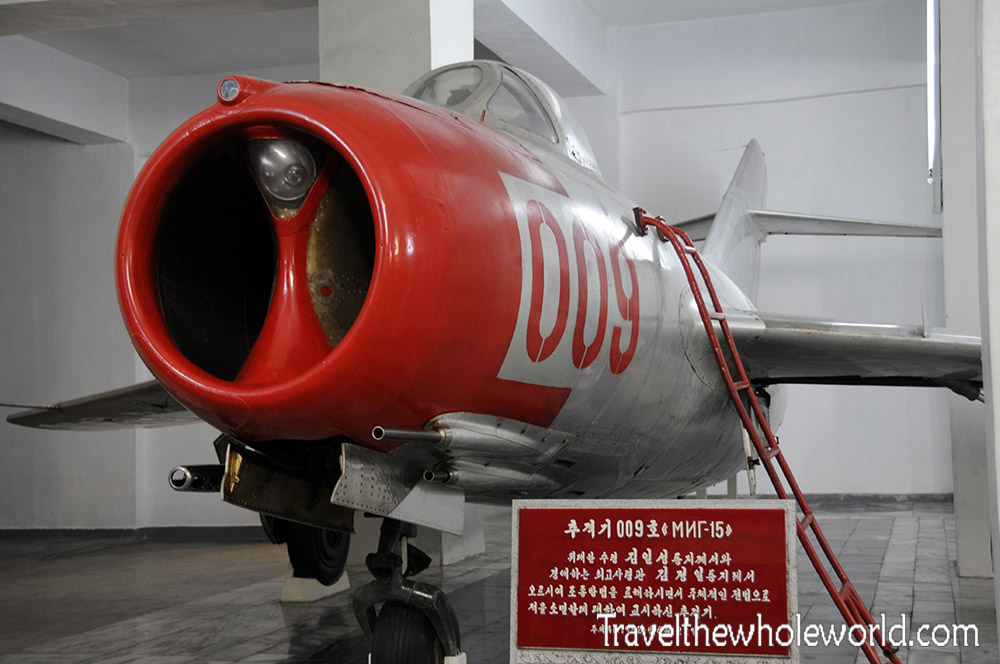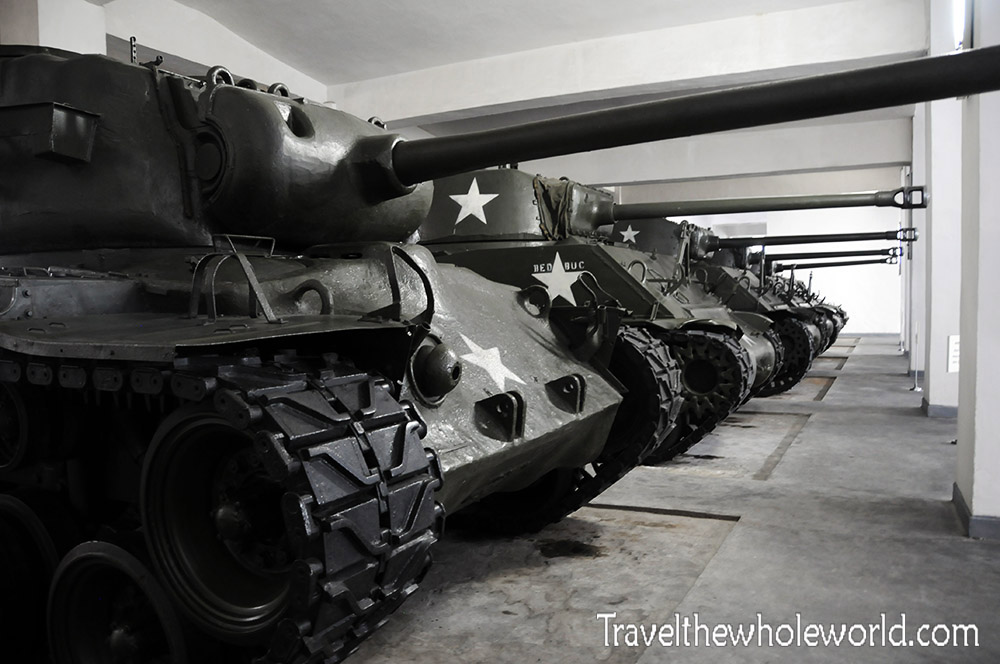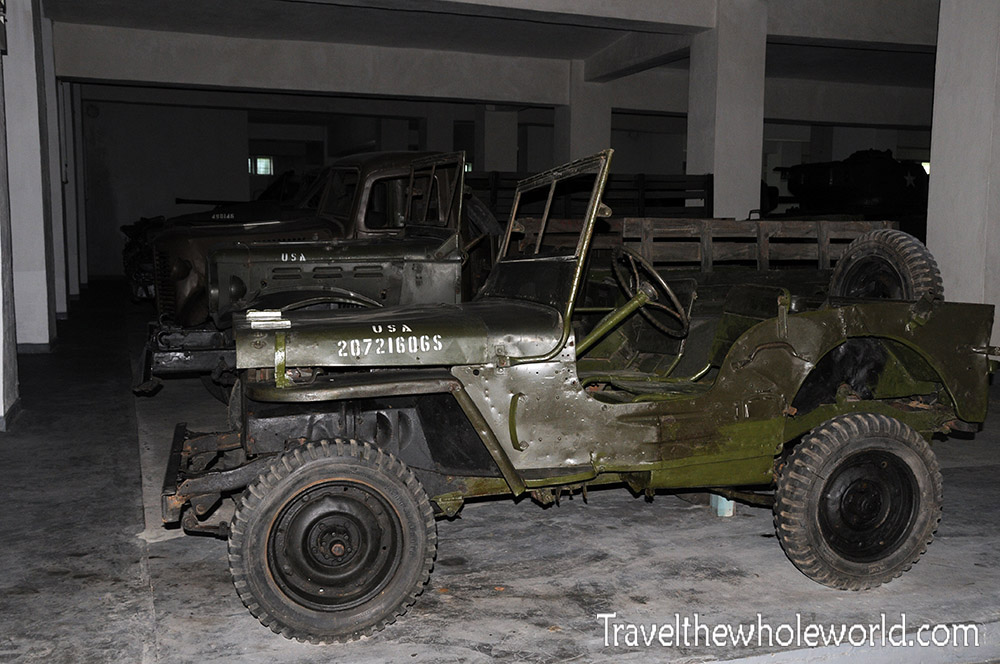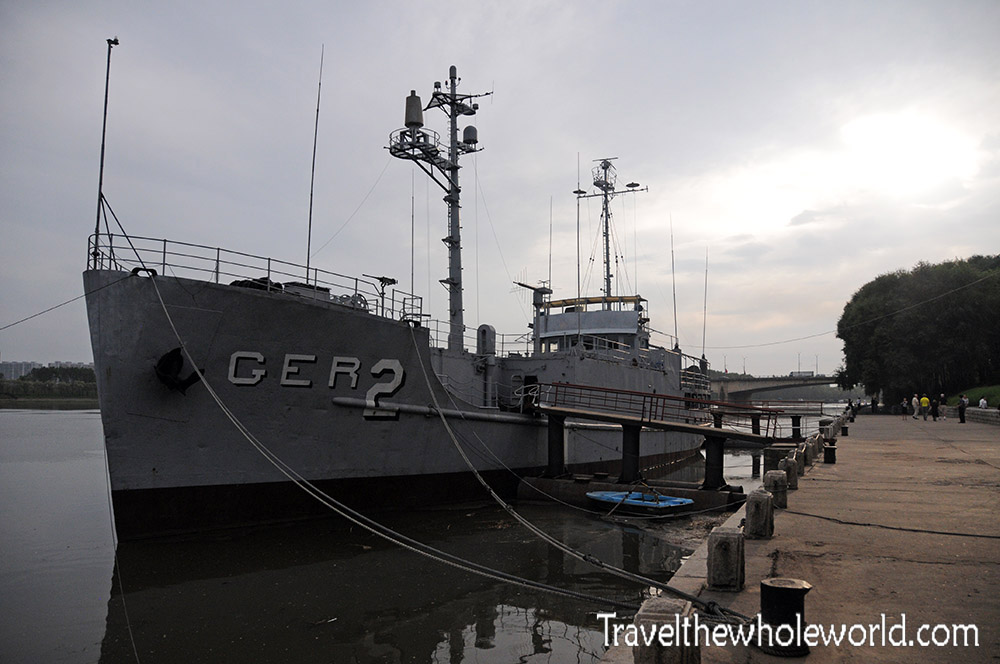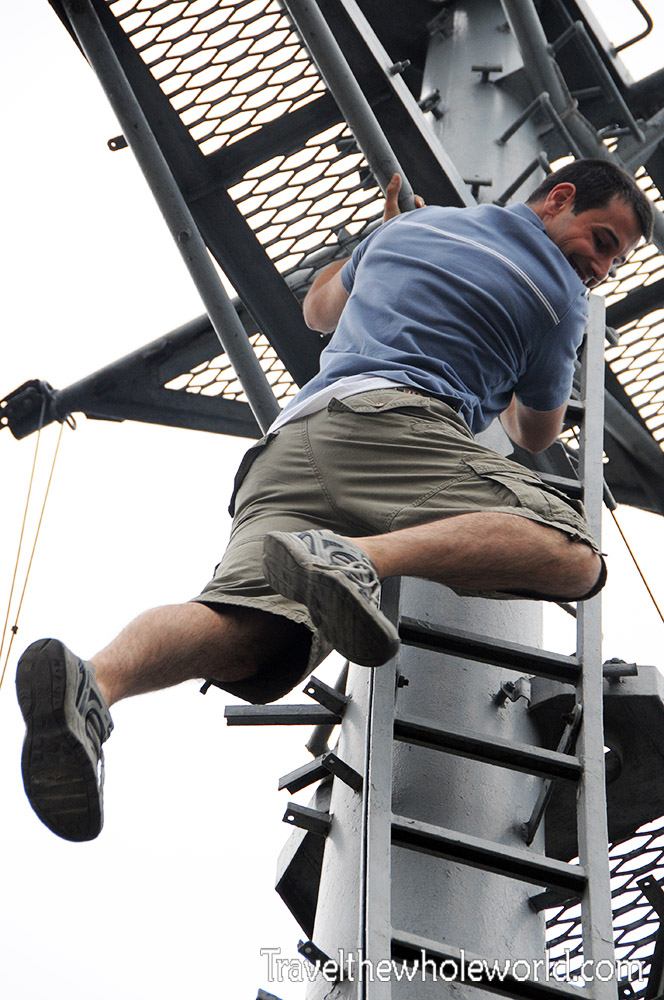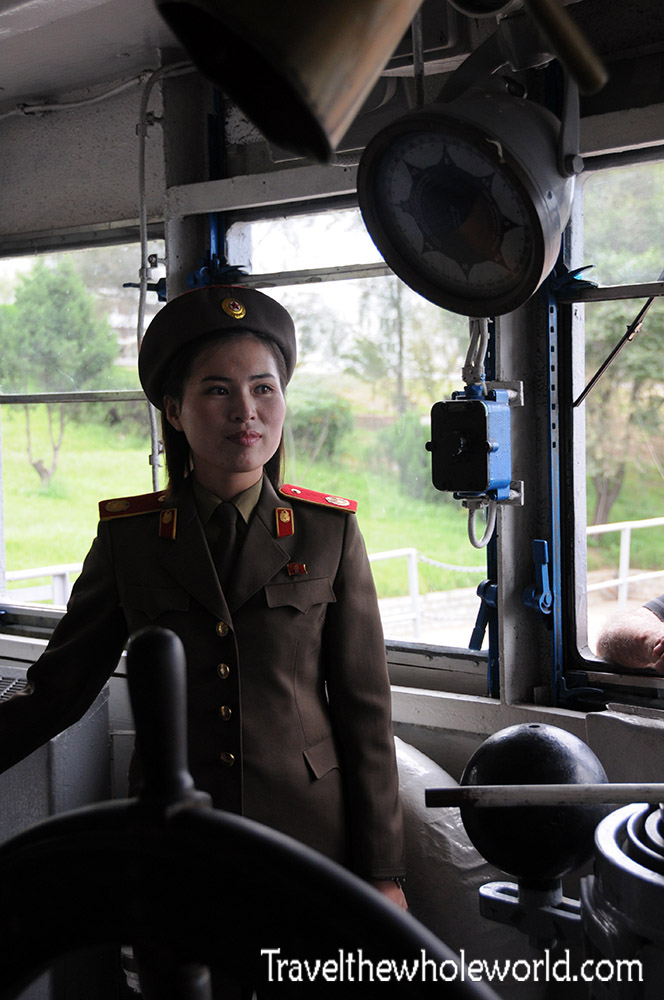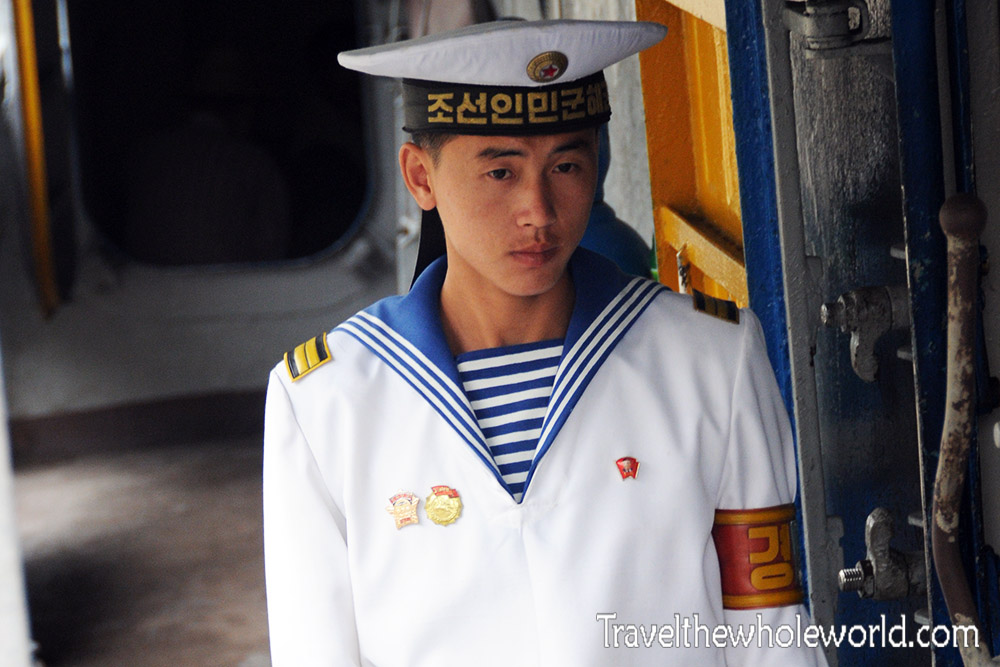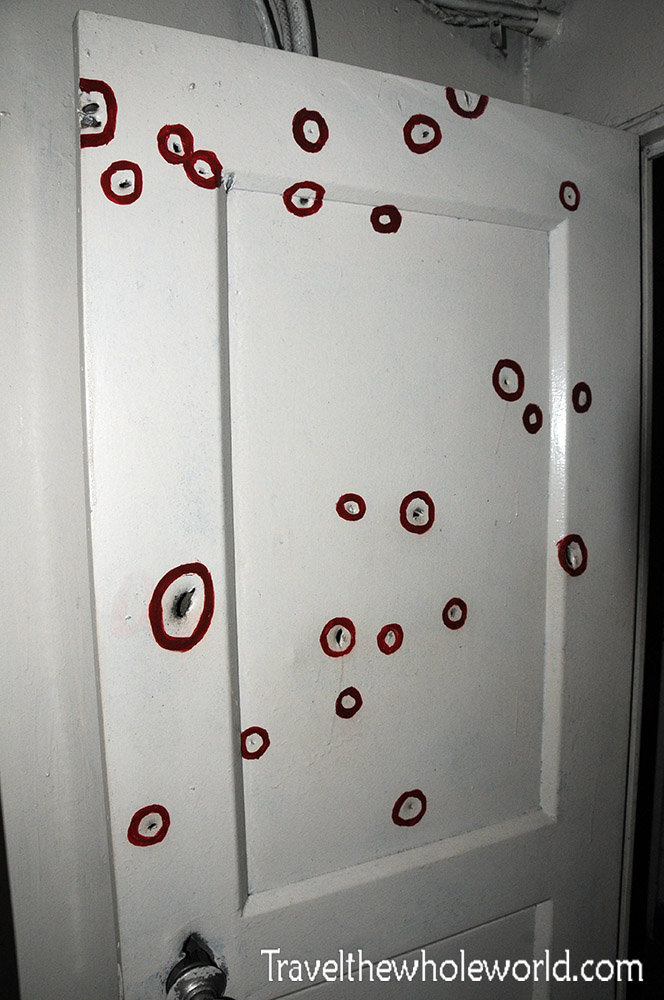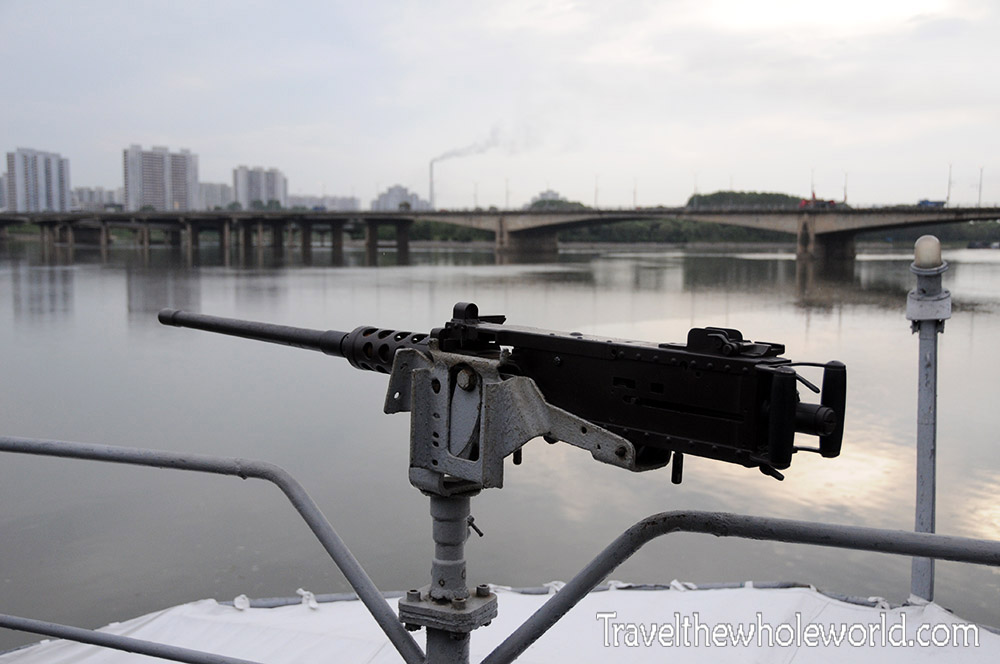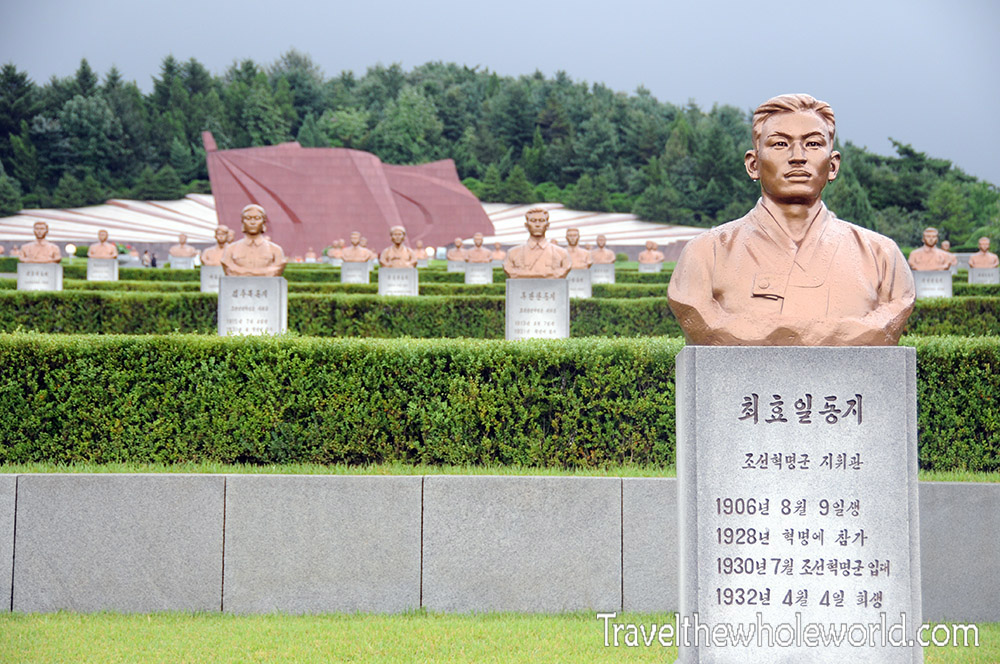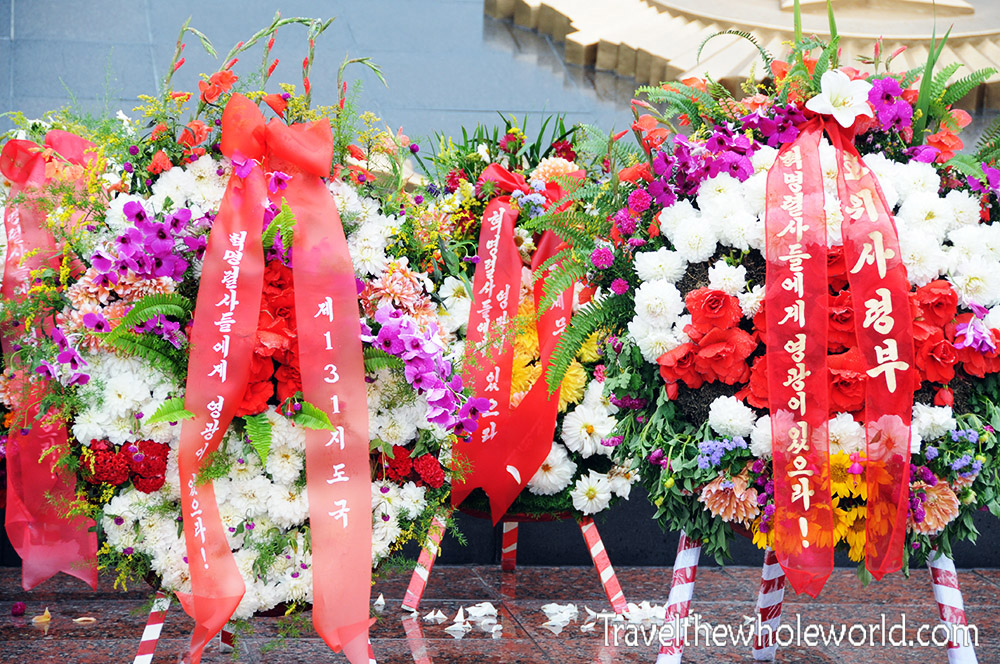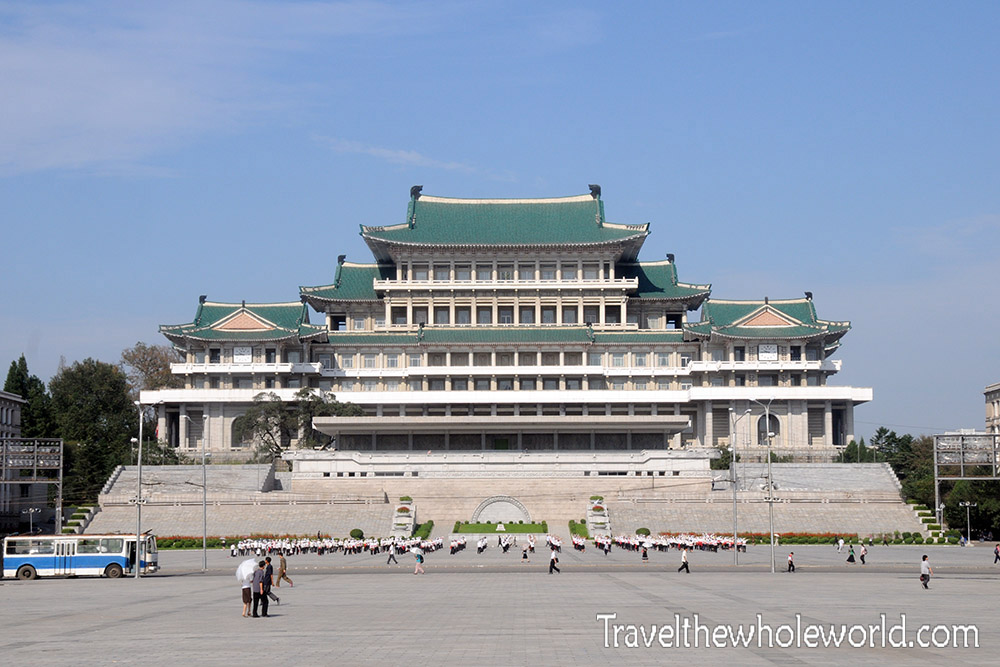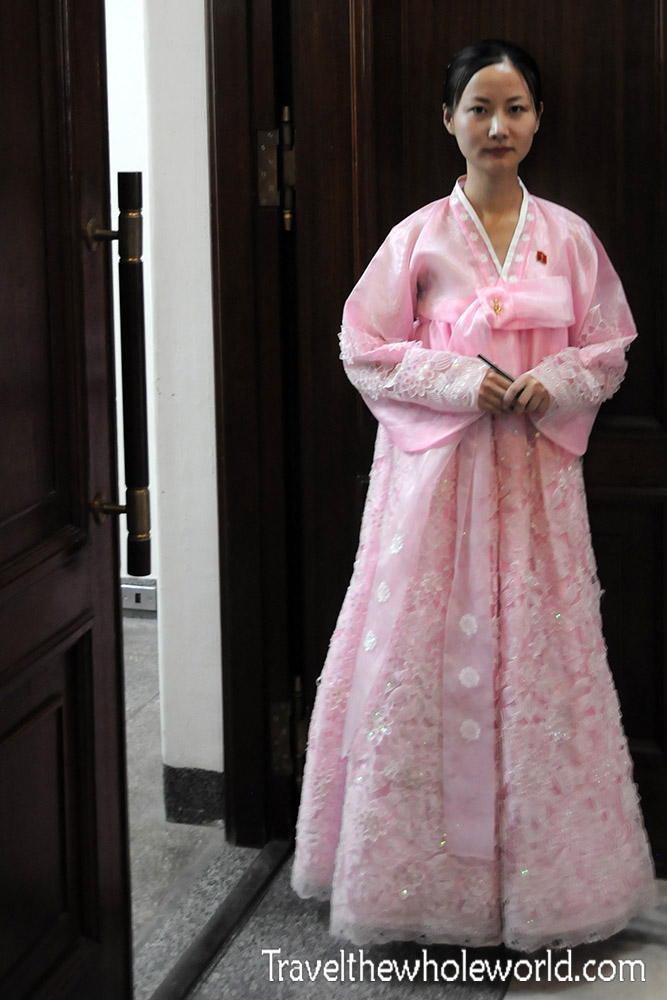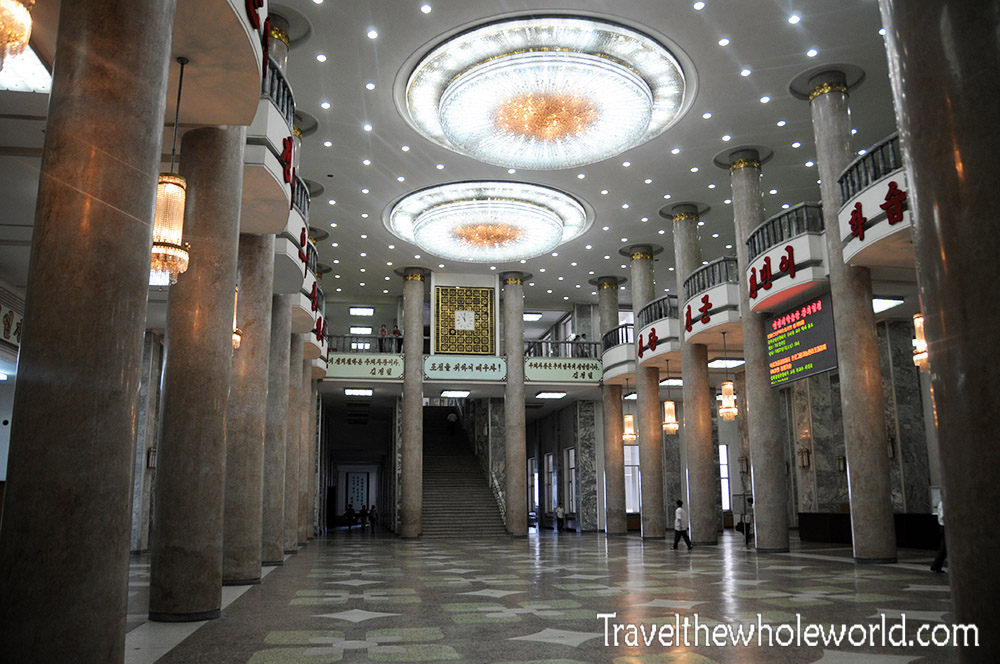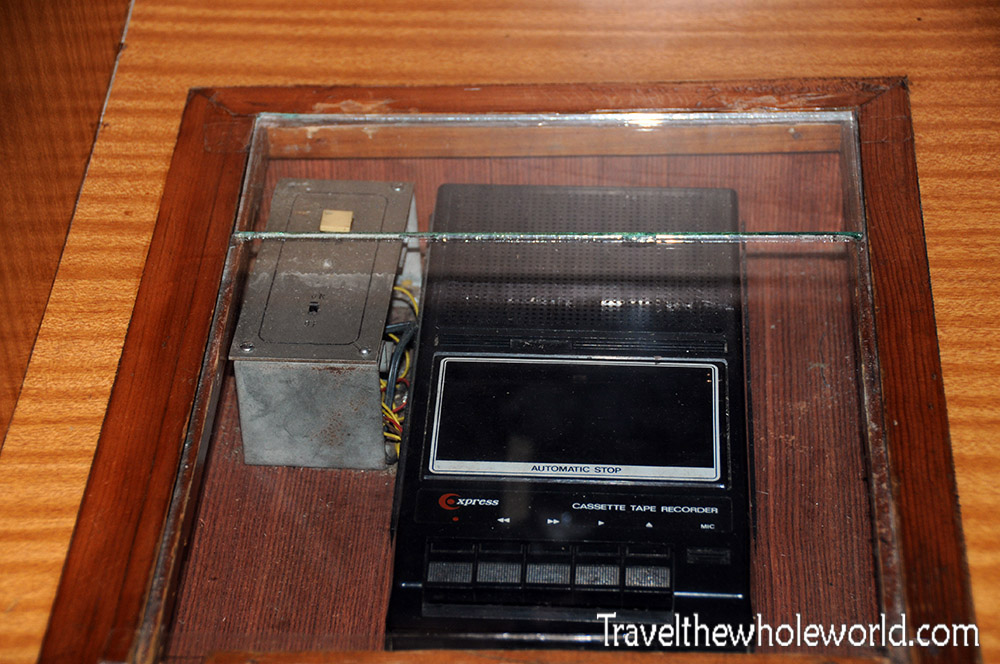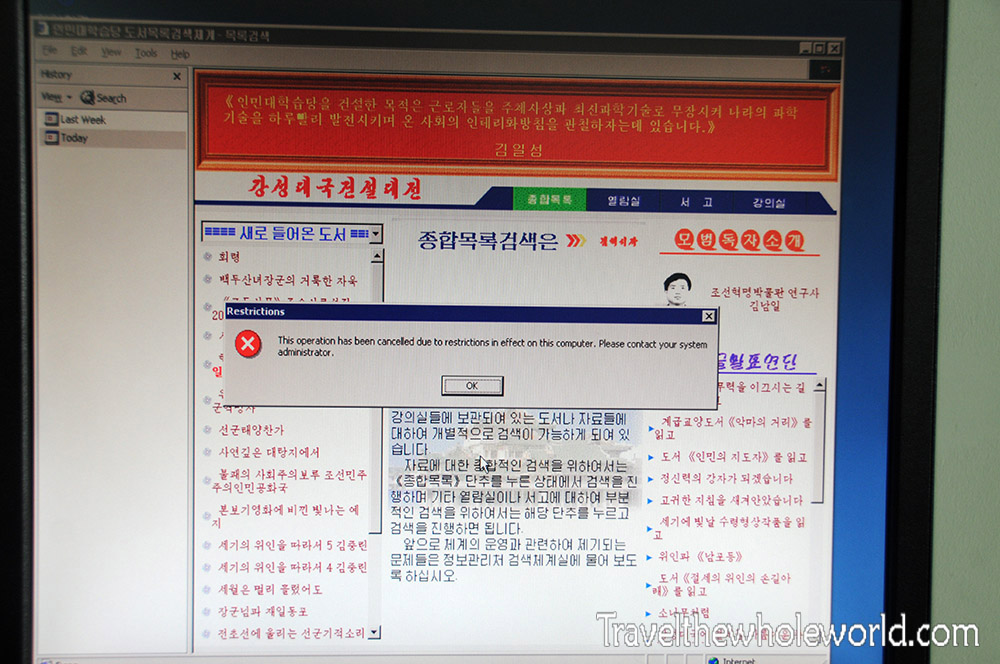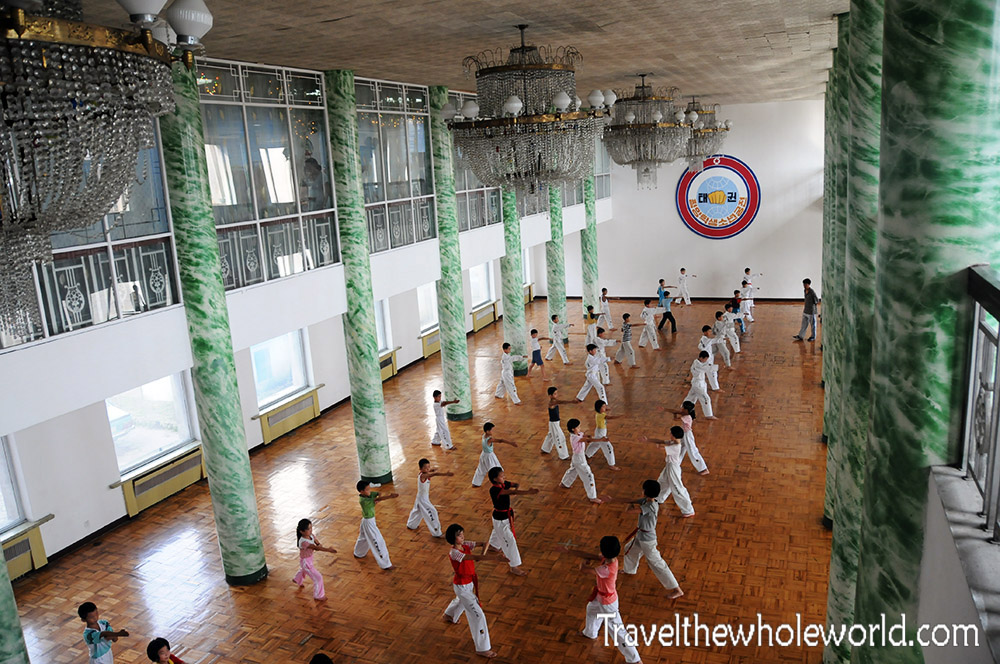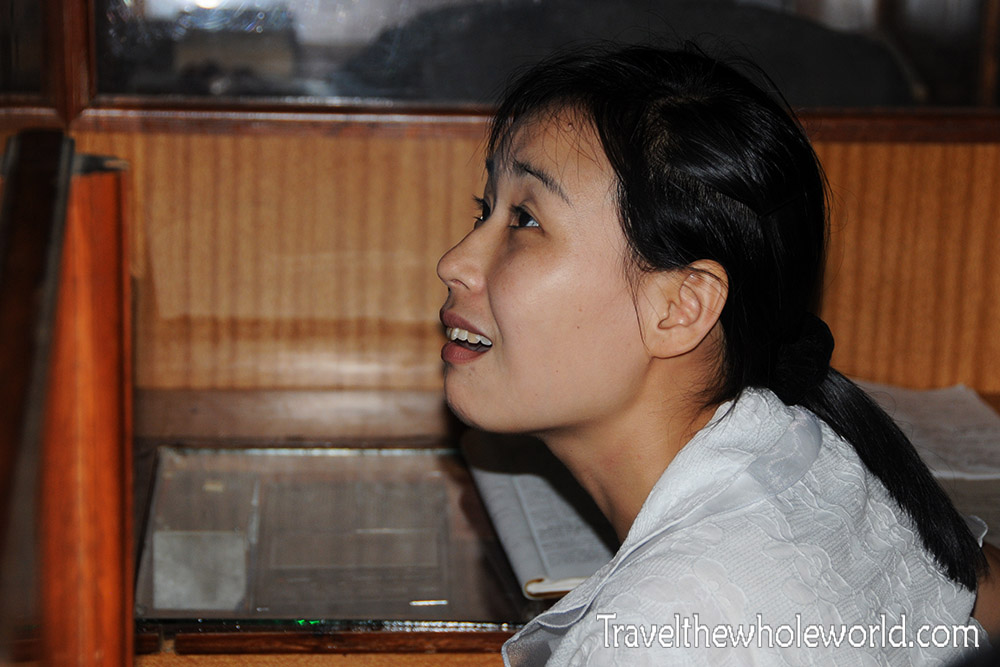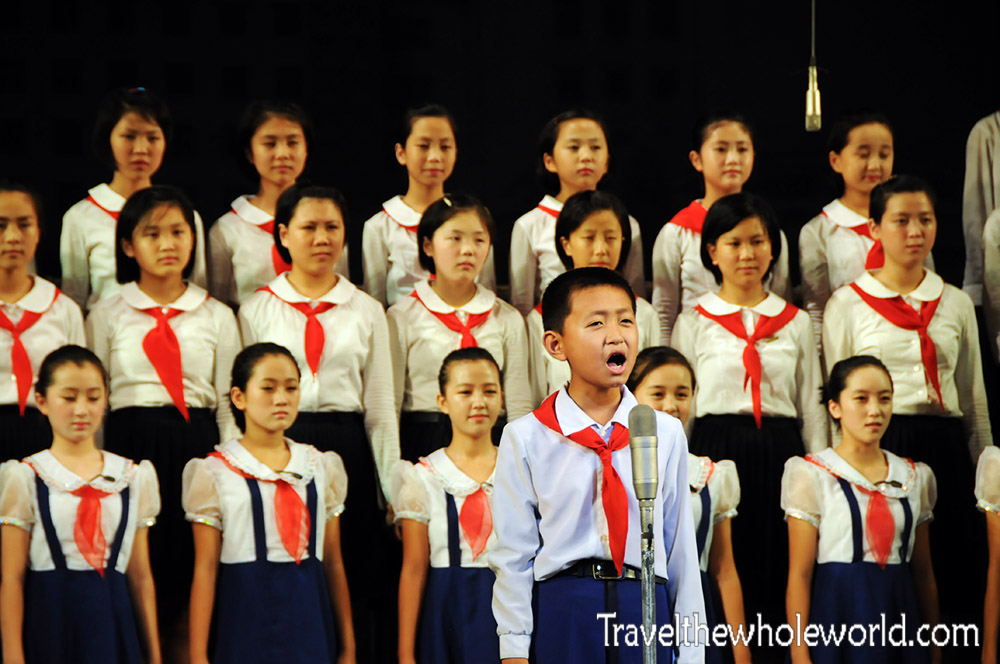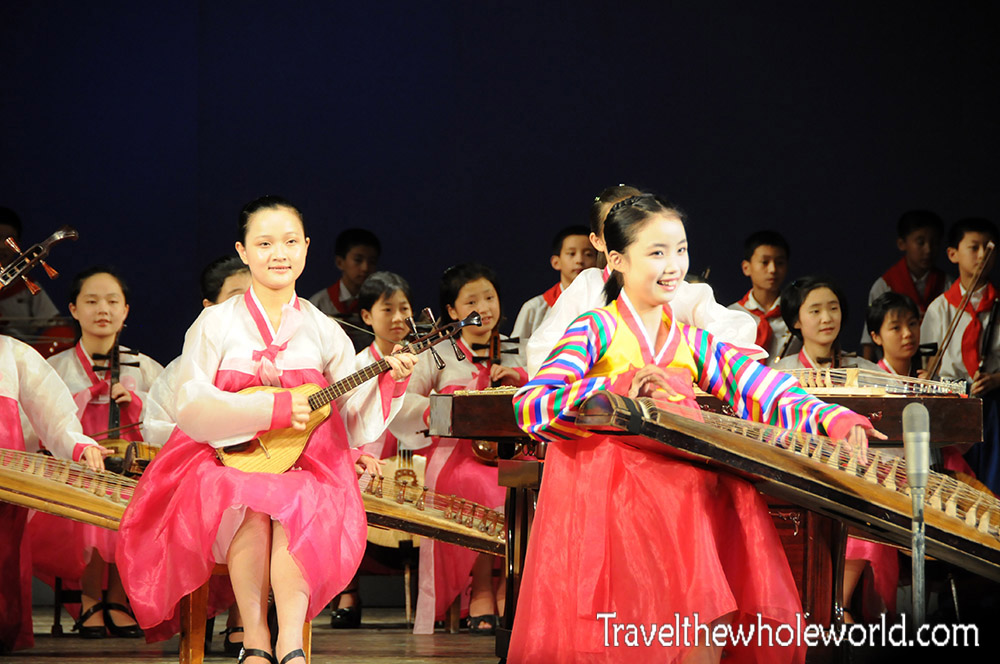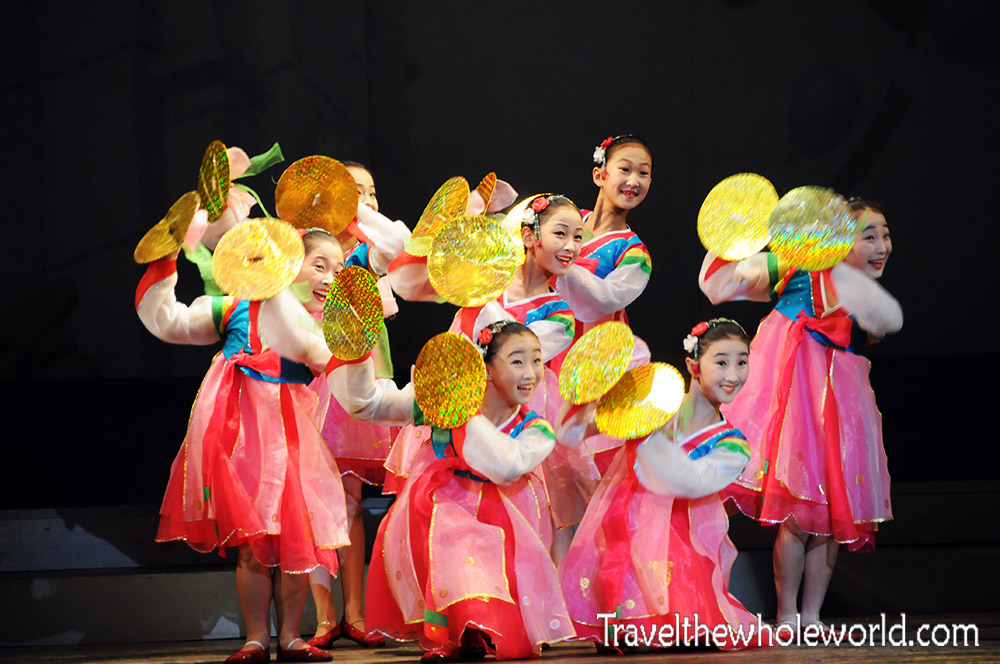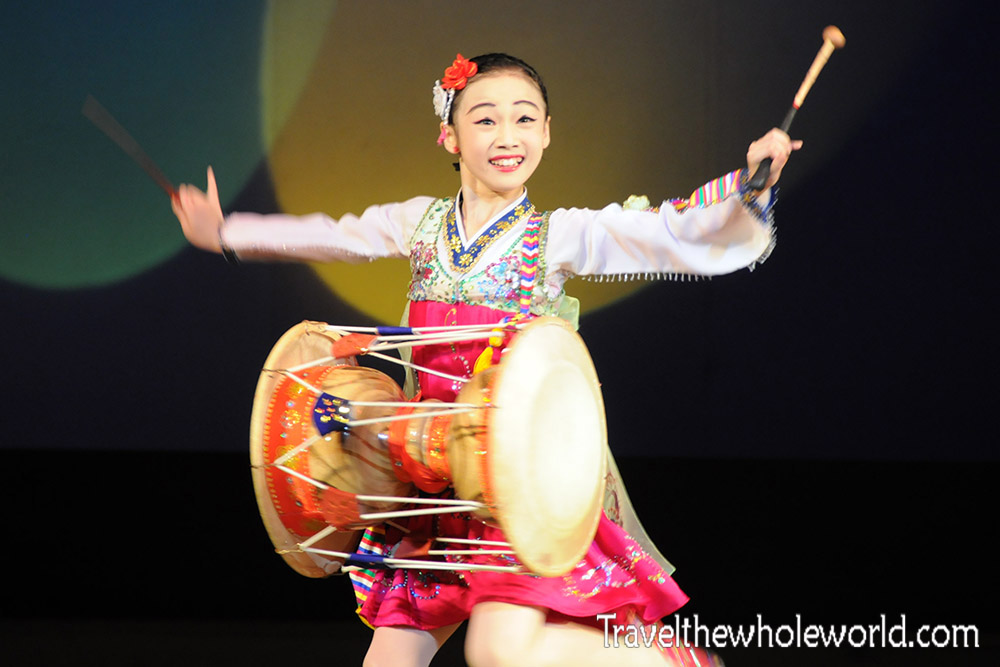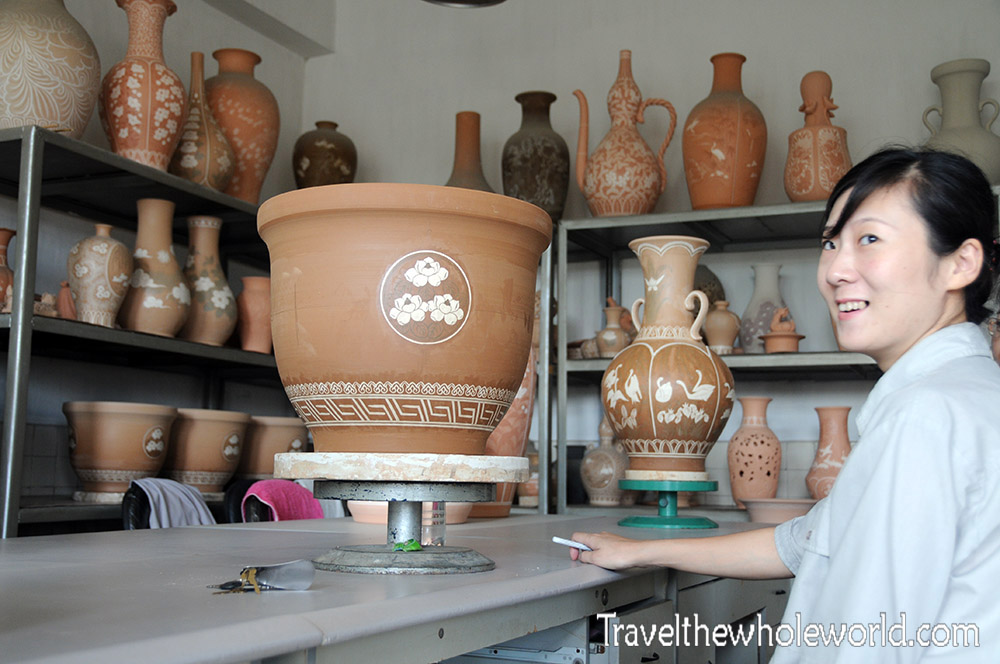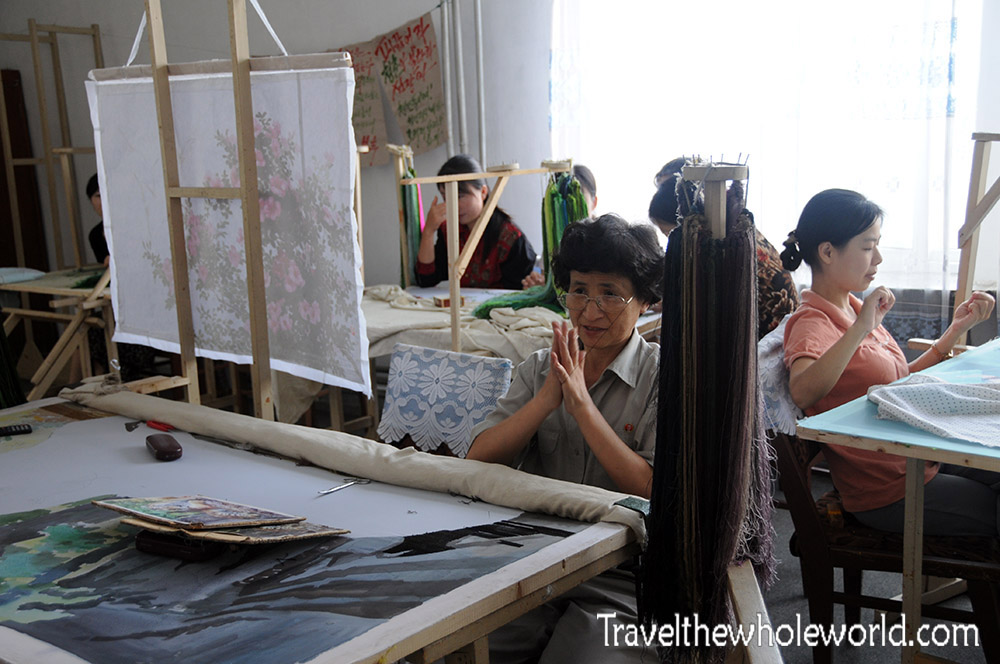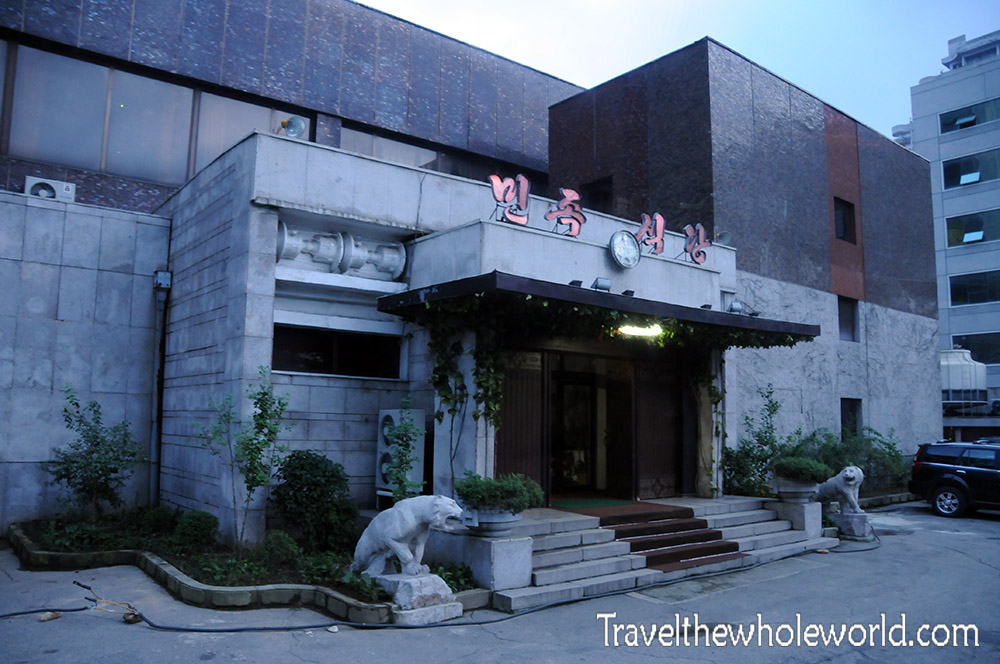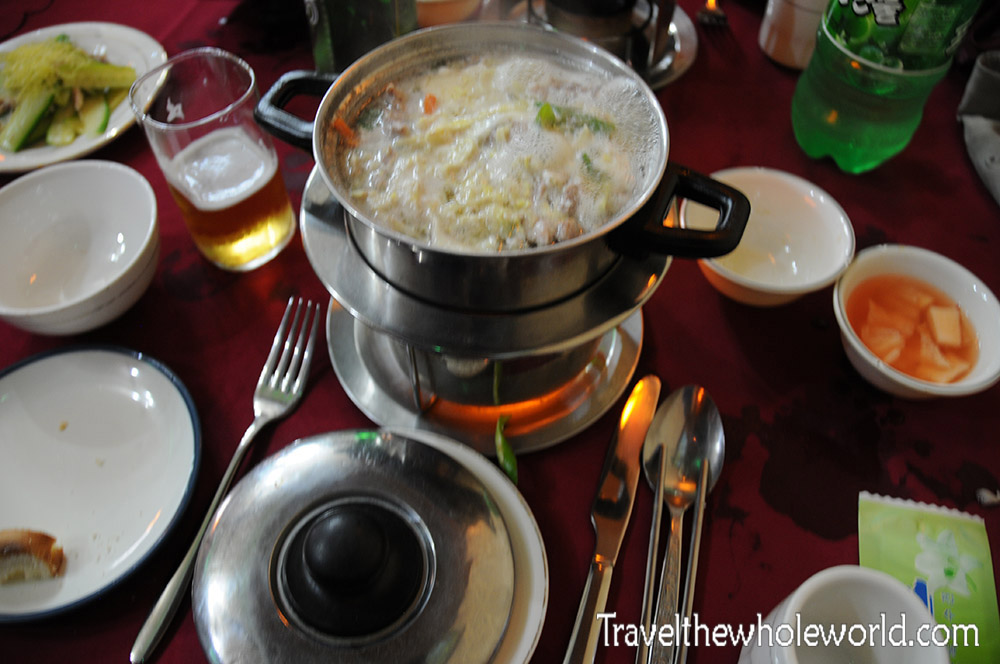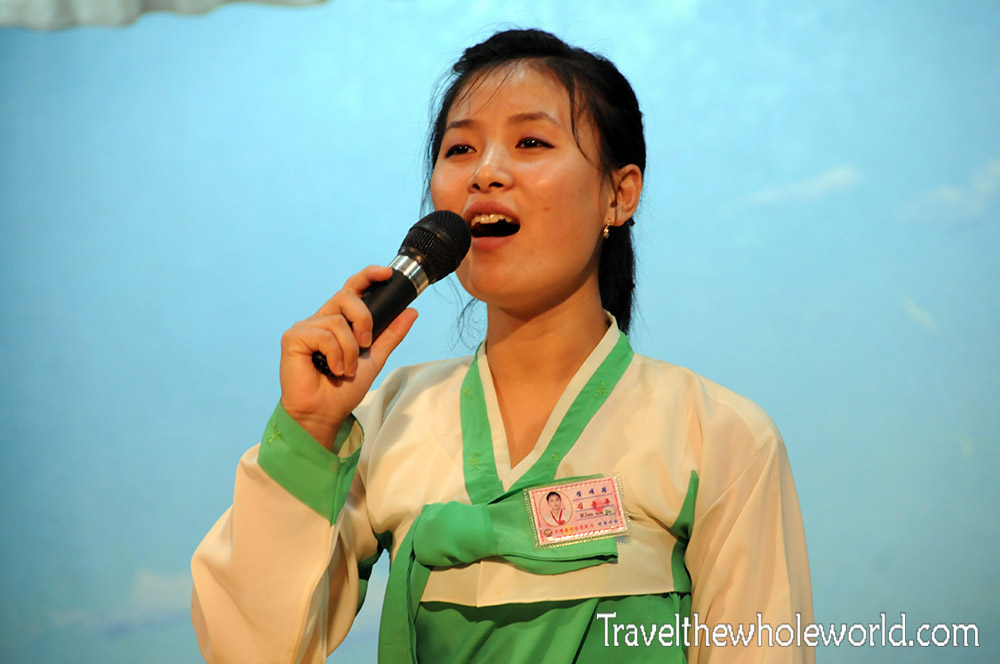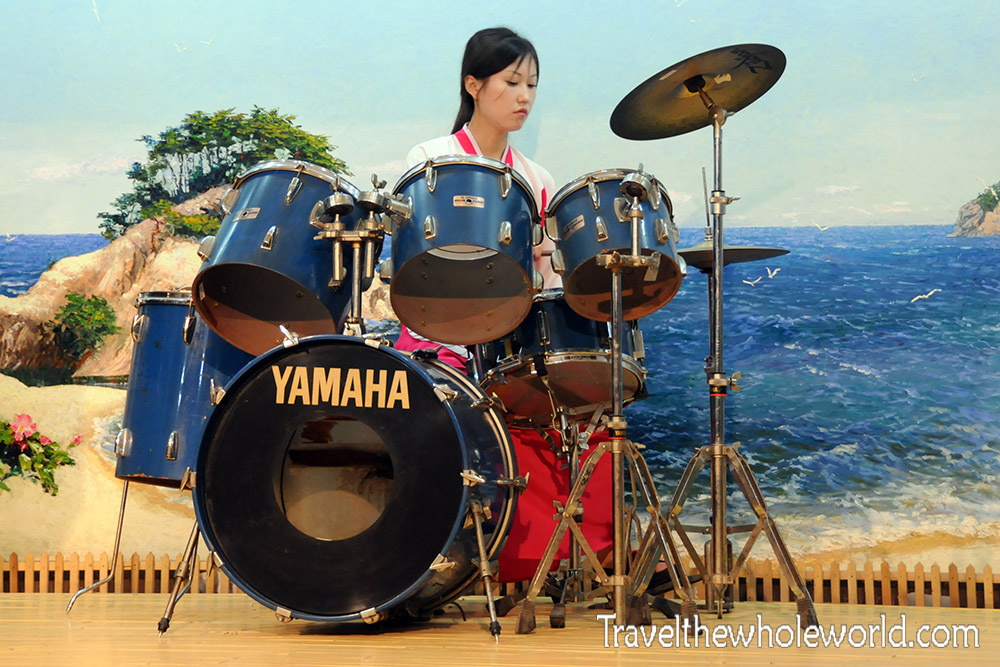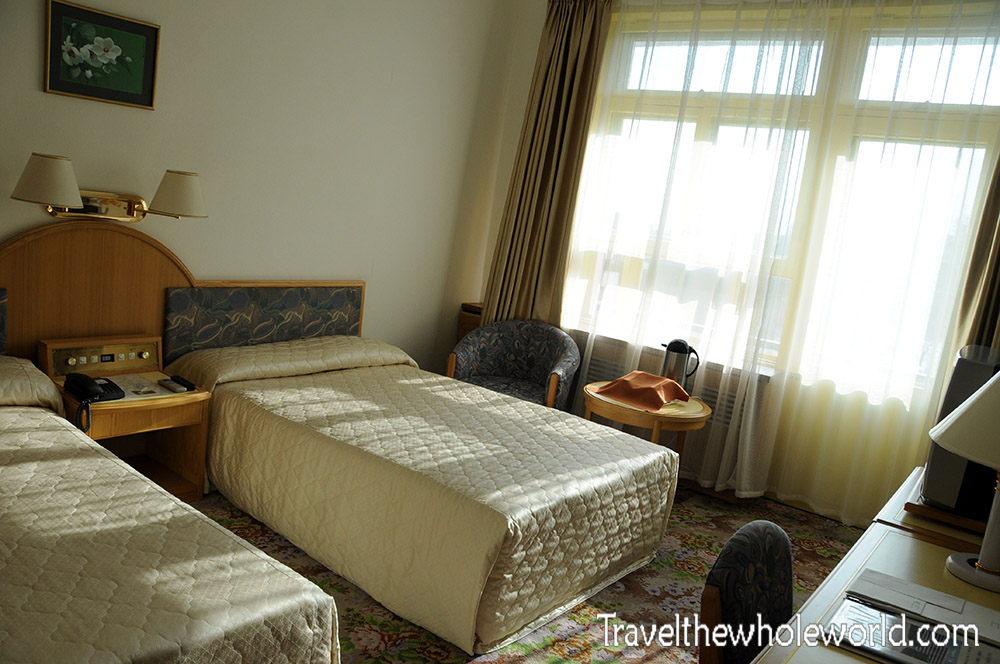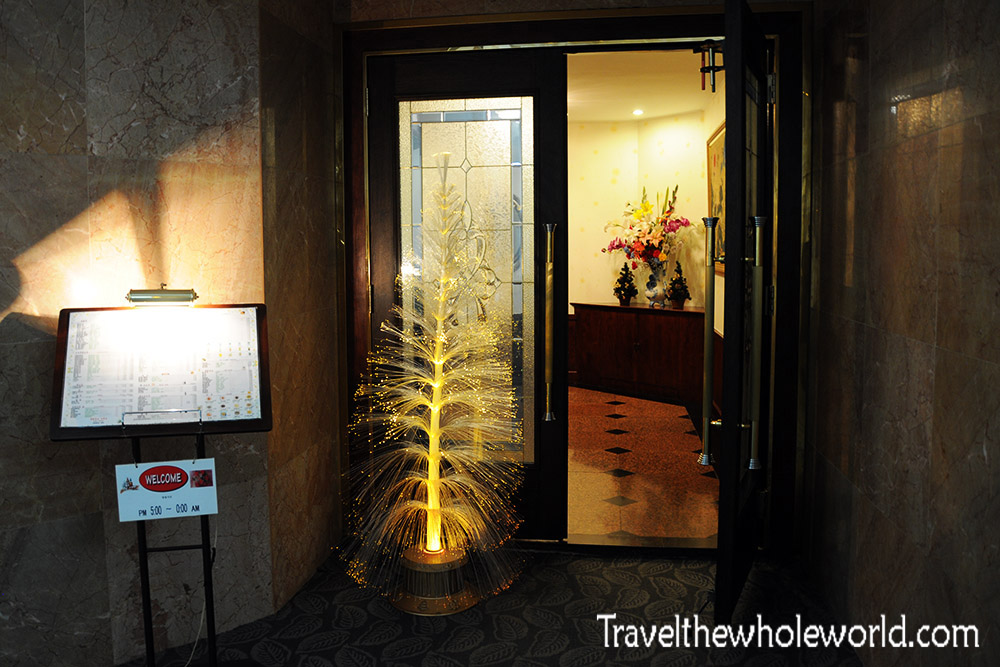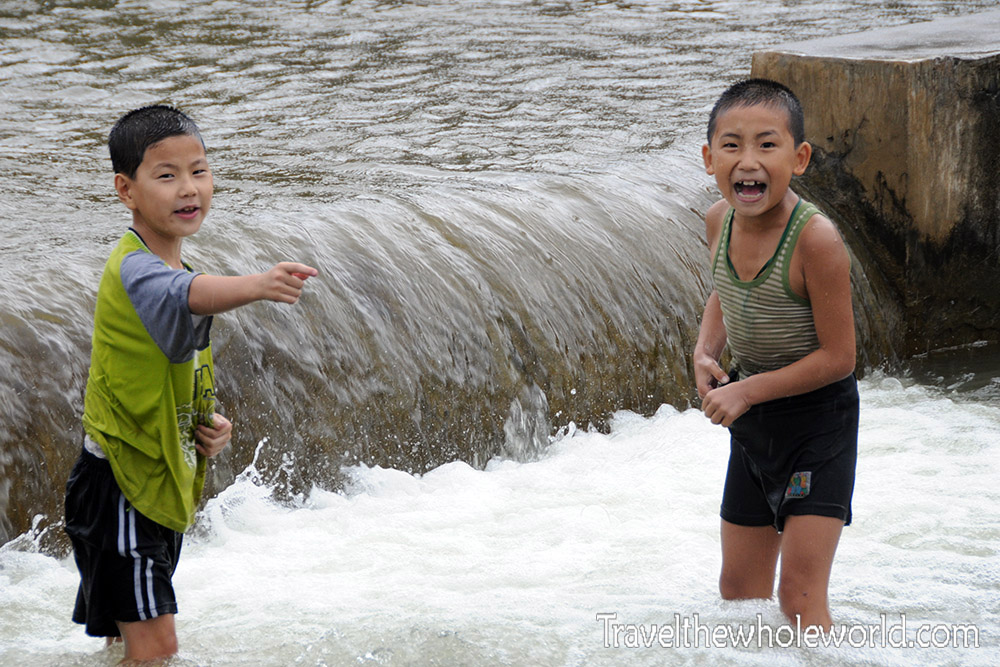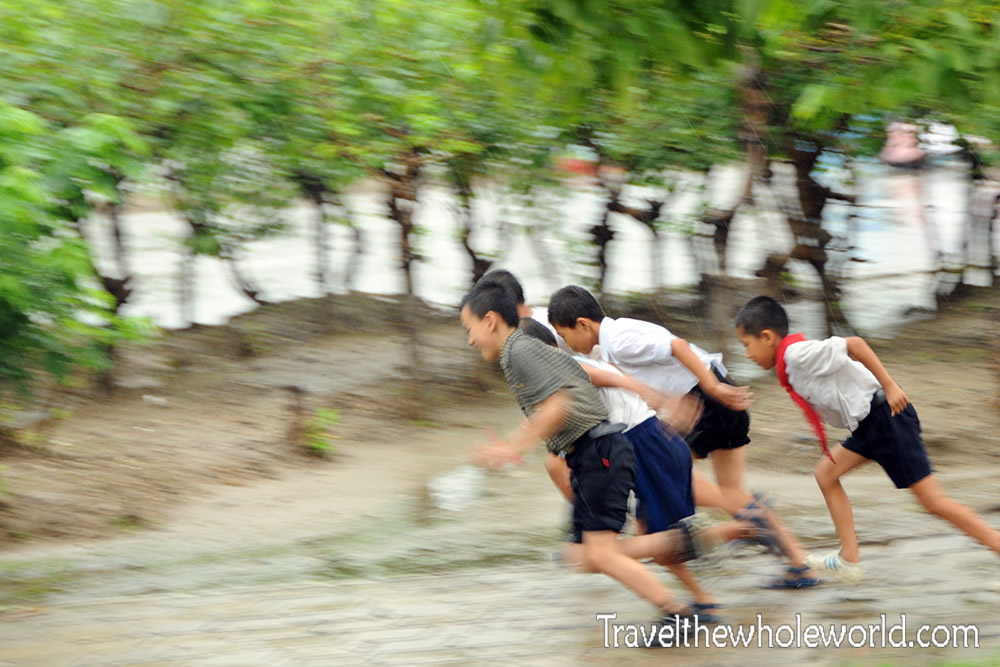Visiting Pyongyang
I spent the majority of my North Korean trip in their capital of Pyongyang. The city is by far the largest in the country with a population of three million. It’s here that you’ll find the majority of North Korea’s memorials, nice restaurants, entertainment, and the upper class. North Korea was founded by Kim Il Sung in the 1940’s and though he passed away in 1994 he is still considered to be the president of the nation today. He is credited by North Koreans for defending the country against foreign imperialism including both the Korean War and World War II. Immediately upon my arrival to Pyongyang Airport, I saw his large portrait while still in the plane.
This large bronze statue was dedicated to Kim Il Sung after he passed away and proudly stands at 65 feet (20 meters) tall. A statue of President Kim Il Sung is built in every city in North Korea and almost every home or office hangs his portrait. I visited North Korea when Kim Jong Ill was still in charge, but he passed away soon after. His own bronze statue now also stands at the same height directly next to his father’s.
As a matter of fact, the first significant place that I was taken to inside North Korea was a trip to the Kumsusan Memorial Palace in Pyongyang. Photos within the palace are strictly forbidden, but I was able to photograph the outside and also get my photo along with three North Korean women. In the far right of the photo is someone I met on the trip who happened to live only 10 miles away from me back in Virginia and is now one of my best friends!
The mausoleum was once the headquarters of the North Korean government, or where Kim Il Sung once ruled from. This is one of the best maintained structures in the country, and the inside was filled with enormous rooms made of marble that were elegantly decorated. After the president’s death, the palace became the final resting place for Kim Il Sung. The late president is preserved in a room and is available for viewing. Many North Koreans were also visiting the mausoleum. A few of the women even got a bit emotional and ran away crying after viewing their former president. Visiting the Kumsusan Palace was certainly a unique experience.
Above is a photo of downtown Pyongyang that has one of the largest portraits I saw of Kim Il Sung. The building at the very top of the photo is the Rungrado May Day Stadium, which is the largest stadium by seating capacity in the world. The Rungrado May Day Stadium has enough room to seat 150,000 people, and it’s here that the world famous Arirgang Games are held.
The Arirang Games are said to be the largest human arts performance in the world, and has earned its place in the Guinness Book of World Records. It’s pretty damn expensive to be honest. A ticket cost me over $200 but this is something you simply can’t miss out while in North Korea! These two photos above and below show a gymnastic performance and a huge crowd of kids after they had finished their portion of the games.
The performance lasts about an an hour and a half and aside from the different stunts, singing and other performances, the Arirang Games overall tells the history of North Korea. The characters created by people in the center of the stadium I learned from a friend means self reliance. In most of these performances there are people seated on the opposite side of the stadium holding up boards to form giant pictures or messages.
There are so many different performances going on during the Arirang Games that I could dedicate an entire page to the event itself! The grand finale though was a giant firework show. The 65 represents the 65 years that North Korea has been an independent nation.
The Arirgang Stadium is built along Pyongyang’s the Taedong River. This region of the city is probably the nicest in the capital, and maybe even the entire country. You’ll find North Koreans riding bikes here, going for a stroll, and a few enjoying the benches or a seat long the river. Along this part of the river are also several statues and memorials. The photo below shows some wealthy North Korean women. Luckily they didn’t freak out when I took their photos!
One memorial along the Taedong river is the Juche Tower. Juche itself is a philosophy and belief that is the foundation of the North Korean government. North Korean leaders believe that by focusing in resilience and independence, their nation will eventually transform to a life of prosperity. If you notice the Juche symbol that the workers are holding up, you can see it’s directly inspired by the Soviet hammer and cycle.
These two photos were taken else where in the city; above is the Pyongyang TV tower which rises to roughly 500 feet (150 meters). Below is the North Korean Arch of Triumph, which is actually much larger than France’s Arch of Triumph! This was built in 1982 to celebrate the resistance from Korea against Japanese aggression. The entire nation seems obsessed with both World War II and the Korean War. Visiting North Korea you’d almost think these were recent events, while to the rest of the world they are history.
This is a random photo I took while in Pyongyang. The building above I was told is actually a large ice skating rink. At night time it’s actually nicely lit up and looks pretty amazing from a distance. I wasn’t able to enter the building, but I’d loved to have seen what it looked like inside.
Here is a city park with the famous Ryugyong hotel in the background. This hotel was not yet completed when I visited, but it was already the world’s 30th tallest building. My understanding was that government ran out of money but an Egyptian construction company took over the project some years later. The building is now completed and is the tallest buildings in the country.
With a population of several million and few people owning cars, the most efficient means of transportation in North Korea is the subway and the trolleys. There are a few taxi’s parked at hotels, but I’ve never actually seen one driving on the road before! It would be almost impossible to use a taxi as a foreigner, so I’m not quite sure what their purpose is since most North Koreans would just take a bus, and the upper class would have a private driver.
The Pyongyang metro stations are beautifully decorated, and were built very deep underground to be protected from aerial attacks. There are several rumors that numerous secret subway lines exist that go to various military compounds that few people know about. If I’m a foreigner and heard about it then I’d assume everyone in the country knows, so that likely isn’t true! When I was in Pyongyang I also heard of another rumor that there is a stop that isn’t marked on the subway map, and if you continue past what should be a dead end you’ll end up at a stop called Paradise. Supposedly there are some luxury services that only the elite can visit.
Trolleys also seemed to be pretty common in Pyongyang. Workers would take these to get to their jobs in factories and other areas outside the city that don’t have subway access. I’m not sure what the primary driver of the economy is in North Korea, but my understanding is they are focused in simple industrial sectors and agriculture.
I hate to write anything negative about any city but in Pyongyang there is no denying that outside the government buildings most structures are not in the best condition. All the apartment buildings I saw where the basic soviet block styles; nothing really more than I-beams and concrete. Above are below are two examples of so”me common types of living arrangements for average citizens. There are hundreds of the giant concrete apartment buildings throughout the city. Some of them must have thousands of rooms but don’t look like they were built with top quality. If an earthquake were to ever happen here in Pyongyang I think this city would be completely destroyed. Imagine Haiti’s damage from 2010 times 10,000.
Since all men are drafted into the military the result is women both young and old are left to run the rest of the country. In all the cities I visited in North Korea I never saw anyone using basic power tools. Of course for construction and their military projects there will be plenty of heavy equipment and whatever is needed to complete the job. As far as daily tasks for ordinary people they all seemed to be using hand tools. These women above are cutting the grass and doing repairs on the street. I saw scenes like this in all parts of the country; cutting grass by hand, using rocks instead of hammers, and other tools that make the job much harder than it needs to be. My guide did a good job of trying to prevent me from taking photos of these scenes. It wasn’t my goal to try to exploit things like this in North Korea but what I see I photograph. Even though this was a propaganda tour to make their country look like a thriving utopia it’s impossible to hide the daily activities.
Taking the photo of the women cutting grass with scissors definitely wouldn’t have been approved of, and I think the same would go for this bag from the UN’s World Food Program. The program is criticized by a lot of countries since they say they have no idea or control where the food actually goes once it arrives to North Korea. Many believe that the food isn’t going to those who need it most, but rather to the regime’s military to keep them loyal.
I was surprised to find both coke and some American liquor like the Kentucky whiskey above in the hotel store. Obviously because of all the sanctions, these are purchased from another country like China and then flown into Pyongyang and sold later. In the hotel you can find some very popular western products such as coke and chocolate. I’m just making up numbers here, but I’d assume the percentage of North Koreans who have ever tried a code is in the single digits. As a foreigner, I was only allowed to purchase things from the hotel store, and a select chosen few out in town. Foreigners use North Korea’s old currency while the locals have a newly printed currency that is in circulation.
At one of the stores for foreigners, I had asked the lady if I could have change in the local currency. She didn’t speak English, but understood what I wanted. I could tell from her vibes she couldn’t careless and gave me change in some modern bills. Later I had showed them to my North Korean guide and asked what the value was. Instead of answering my question he suddenly looked at me hard and asked how I got the bills. I explained the situation and he kept asking me more questions, who gave it to you? What store? Which lady? After the conversation was over he simply looked at me and said you’re not supposed to have that, but never made an attempt to take the new bills from me. This kind of worried me so I donated them to someone else 🙂
I hadn’t realized that holding modern currency was such a big deal. Of course I always knew to never photograph any military activity while in the country. I did find this old military truck, but took its photo since it appeared to be in use by civilians. It’s pretty similar to what I saw most of the soldiers riding in. A lot of their trucks looked like they were straight from the 1960’s or the old TV show MASH, and you really get the feeling that you’ve stepped back in time in many ways!
The modern way of life in North Korea all is because of the vision of their founding father Kim Il Sung. Within the capital is supposedly the location that Kim Il Sung was born in. His birth was in 1912 where he allegedly grew up in this humble cabin with his family.
The cabin has been rebuilt, but some of the original tools and items that he used as a child are here on display. His son Kim Jong Il was allegedly born in another cabin in the foreground of snowy mountains in the northern parts of the country. During the Arirang Games, they even showed a performance with a giant picture of Kim Jong Il’s birth place in the background.
Kim Il Sung’s history is mostly determined by the North Korean government, and usually conflicts with both Western and non-western sources. Regardless, it is agreed Kim Il Sung was born to humble beginnings in Korea, and first became involved with communism as early as the late 1920’s. He eventually joined a communist militant group and by the time he was 24 he led a small party that attacked a Japanese controlled town in Korea and successfully drove them out. After this incursion, the Japanese retaliated and Kim Il Sung fled to the Soviet Union where he spent 26 years there in exile. With the help of the Soviets, he was later installed as the leader of North Korea and ruled with his own Stalinist style government. The photo above shows a North Korean painting of Kim Il Sung in battle.
The Allies are largely credited for ending World War II by driving the Japanese forces back to their homeland and finishing them off with the atomic bomb, but in North Korea, students are taught that Kim Il Sung single handily led an army that drove the Japanese forces out of the Korean peninsula. North Koreans are also taught that he began to join militant groups as early as 14 and while still a teenager he was battle hardened and a well experienced commander. The photo above depicts Kim Il Sung after World War II, and is being greeted and celebrated by North Korean children, common citizens, and his own military.
The North Korean version of the Korean War is even more interesting than World War II. The video being shown to me was the most amazing part of the tour. I had long heard that North Koreans believed the United States had started the Korean War, but as an American this was so exaggerated I found it difficult to believe that anyone here honestly accepted that. When the Korean War actually started, the Americans and South Koreans had very short notice of an attack, and as a result they were immediately pushed back by the North, almost entirely off the peninsula. Once reinforcements were sent in and more support arrived, the South Koreans and Americans were able to take back this lost ground and push back the North Koreans close to the Chinese border.
The North Korean version is that the Americans made enormous profits during World War II selling military equipment, but after the war the great depression began once these profits suddenly stopped. (North Korean version is that the American great depression began in the late 1940’s, not in the late 1920’s.) Due to the desperate economy, the Americans planned for a year the attack on the north in order to control the world and to begin a war where they could make profits again. Of course to common citizens, they can only hear this side of the story, so almost all North Koreans have no reason to believe this to be false information, and you can begin to understand why they follow their leaders so strongly. To an average North Korean, their leaders were the first people in the world to defeat the Japanese and later the Americans, and the rest of the world is in shambles and is desperately poor while they are living the good life and are fiercely independent. Above is a painting depicting the North Korean war. Below is a captured American war plane on display.
These two surrounding photos are from the War Museum in Pyongyang as well showing captured American tanks and jeeps. According to the guide, a North Korean aircraft on display was responsible for downing numerous American and South Korean aircraft in dog fights. Other items on display included uniforms, destroyed gear, artillery, and even letters written by westerns during the war.
North Korea’s most prized possession of all the American equipment captured is the USS Pueblo which was taken in 1968. The US version of the story is that the boat was traveling in international waters when it was captured by North Koreans, but the North Koreans say this was a spy ship in their waters who didn’t respond to any communication attempts so it was then boarded and the crew arrested. Above is the ship docked in Pyongyang, below is myself after getting permission to climb to the top of the ship’s largest mast.
Above and below are two photos aboard the USS Pueblo, including a North Korean sailor who maintains the ship. The US originally requested that the ship be returned to the states, but it will likely remain a trophy by the North Koreans forever. When this incident happened it sparked quite a scare with fear of a new Korean war being flaring up again. 83 Americans were captured from the USS Pueblo and one American was killed. After 11 months they were returned home after the United States signed a document taking responsibility for trespassing in their waters. A year after I visited Pyongyang I saw something about North Korea on TV, and this same lady in the photo above was doing an interview.
I never realized all the fighting that took place when the ship was taken over. Above are bullet holes that were sprayed into the ship after it was boarded. The photo below shows the large machine gun on the USS Pueblo against Pyongyang in the background.
From it’s modern day confrontations with the United States and South Korea to its ancient battles against Japan, North Korea has seen a fair amount of war. The country honors their own veterans by burying them in Martyr’s Cemetery which is located in Pyongyang on top of Mt. Taesong. This is North Korea’s equivalent of USA’s Arlington Cemetery. The cemetery was founded in the 5th century on the remains of an old fort. You can see most of the graves above date back to the earlier parts of the 20th century. Below is a grave likely from a more recent death that has been decorated by flowers.
The rest of my time in Pyongyang was spent mostly visiting cultural areas, such as the Grand People’s Study House. It was built in the 1980’s by Kim Il Sung as a way to honor his 70th birthday. The Grand People’s Study House has over 600 rooms with a capacity for tens of millions of books. There were dozens of people in here studying books, receiving lectures and even listening to music. The woman below was my the escort for the building.
The photo above shows the entrance and main hallway to the study house. Even though there are over 30 million books here, the vast majority are of course North Korean. My understanding is there are of course several rooms containing foreign publications, but all of these require special permission for ordinary North Koreans to read.
The building itself is pretty impressive, but most of the equipment that is actually used is ancient. The tape recorder above is one example of some technology that has been obsolete for decades. Some rooms were also still using boom boxes to play music that appeared to be from the 1980’s!
I did see some computers however, and there was even a room that had flats screen monitors. North Koreans using Internet is absolutely impossible. Even as a foreigner, I had no opportunity to use Internet or any type of communication. I was completely cut off from the rest of the world during my entire stay here. To be honest, I’m not even sure if the average person in North Korea even realizes that there is such a thing as the Internet! There is the intranet though, an internal program sponsored by the North Korean government, but it’s impossible to view websites from outside of the country. I did try to bring up a browser and got this message.
For a small performance, I was taken to the Children’s Palace where students learn music and performing arts. Above are some kids learning Tae Kwon Do in the Children’s Palace, below is a female student from the Grand Study Hall.
The surrounding photos are from the Children’s Palace, where they put on an hour performance. The events included everything from singing, playing instruments, dancing, and Tae Kwon Do.
I’m not sure how the kids are selected or entered into the Children’s Palace, but all of them were definitely good at what they did. I suppose the benefit of such a structured and strict society leaves these kids with nothing else to do but to master performing arts and studies.
I almost never buy souvenirs, but in North Korea I made a big exception. Most things in North Korea are extremely cheap, like for example their subway system costs about 3 American cents per ticket. As a foreigner though, when it comes to shopping and souvenirs don’t expect to find such great deals. These women e were working in different places doing pottery and creating other art work. I saw some large paintings that I would have bought if they weren’t so expensive, over $100, and difficult to mail back to the states. They also had some amazing pottery work. One of the most impressive was a giant pot that must have been seven feet (2 meters) tall and was beautifully decorated.
For breakfast, lunch and dinner, I ate nothing but Korean food during this entire trip. Above is a photo of a restaurant with my dinner in the picture below. I’ve eaten Korean food plenty of times in my life, but of course not on a daily basis, so by the time I left the country I felt like I knew all their cuisines really well. I never liked cabbage before my trip here, but kimchi certainly grew on me and I learned to like it!
The first restaurant I visited in North Korea actually had a live band. A woman played a piano while one played the drums and four singers came on stage. Obviously the song was in Korean so I’ve no idea what it was about, but music always goes well with dinner.
I stayed at several different hotels in my stay in North Korea. This hotel was my first accommodation in Pyongyang. The rooms were pretty reasonable and considered to be 5 star hotels by North Korean standards. The door below is actually the entrance to the hotel bar, where they sold some foreign imports. I was warned by another American I met that there would be a quiet plain clothed North Korean government worker at the bar monitoring my conversation.
Pyongyang is definitely one of the most unique cities I’ve ever been to. It remains the last capital of extreme communism and there simply isn’t any other city in the world like it. Obviously as a foreigner I had a propaganda tour and the true hardships of the city and country were hidden to me. But this is the best and only way to get a sense of the place and it was one of my most remembered trips. One thing I certainly learned from traveling, regardless of what type of country you’re in or where you live, kids will always be kids! Most of the youth in the capital seemed to spend their free time doing what any kid from other cultures around the world would do.
